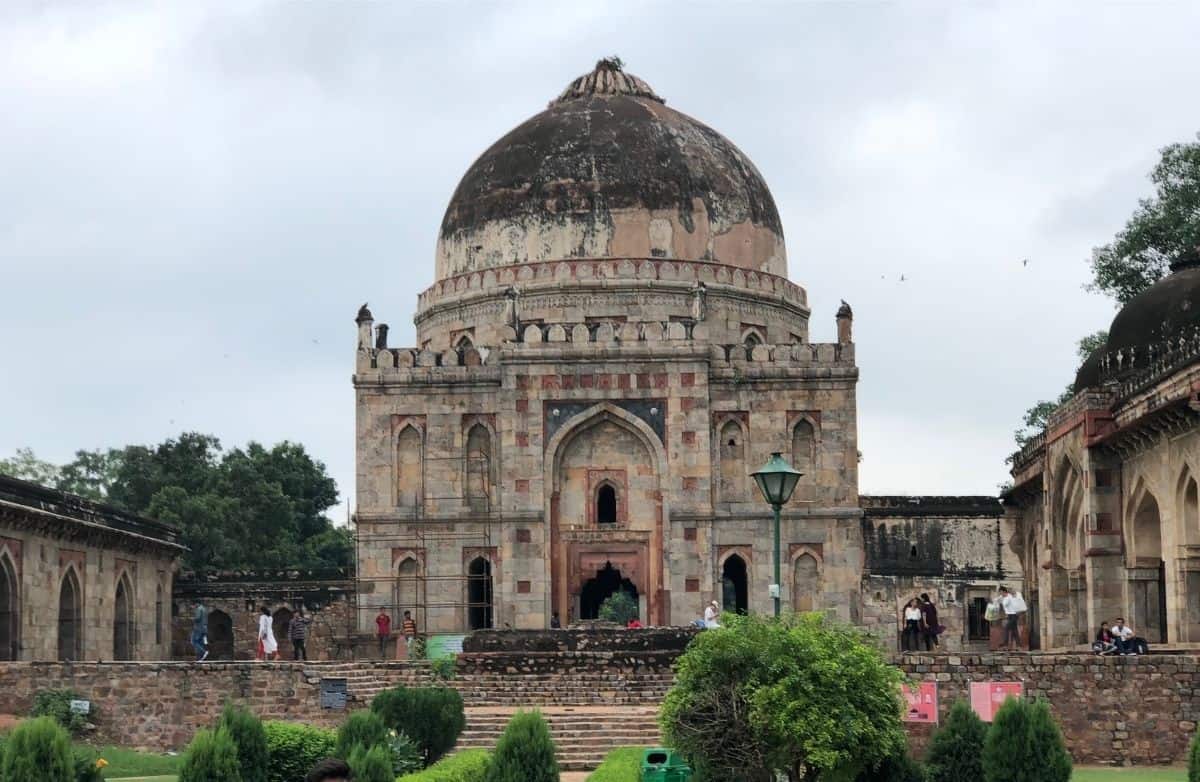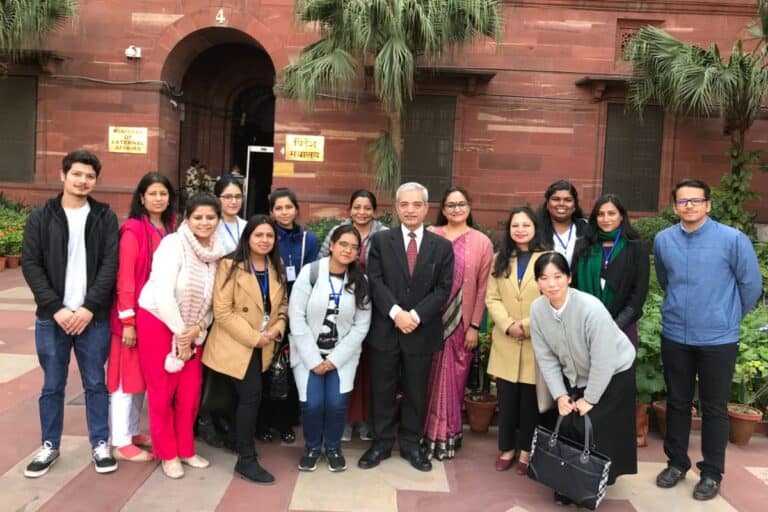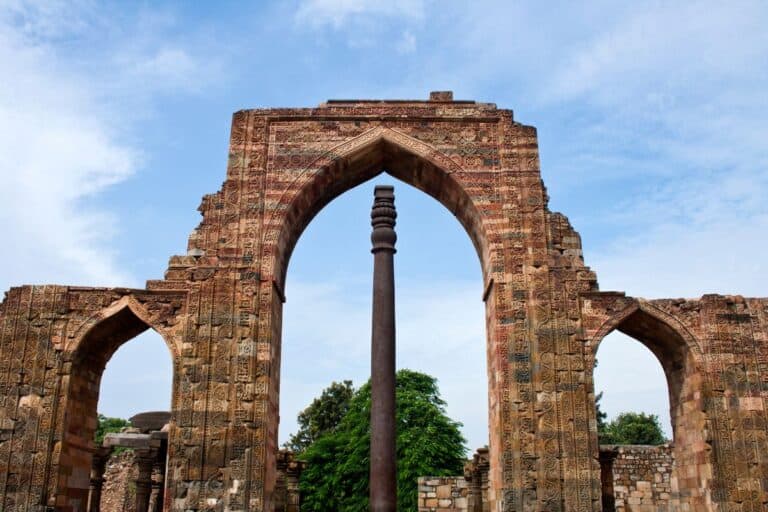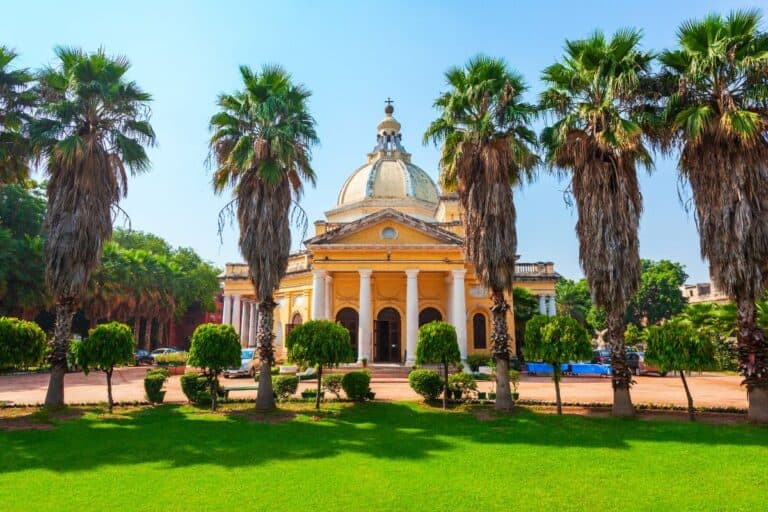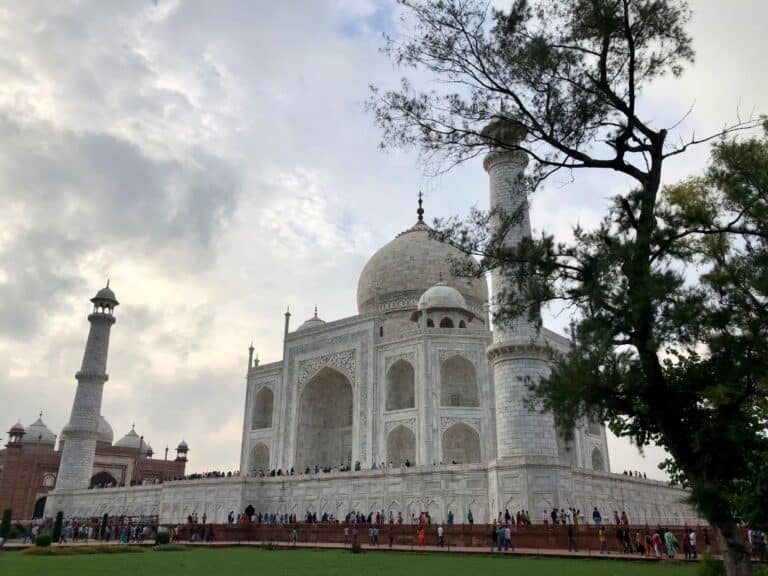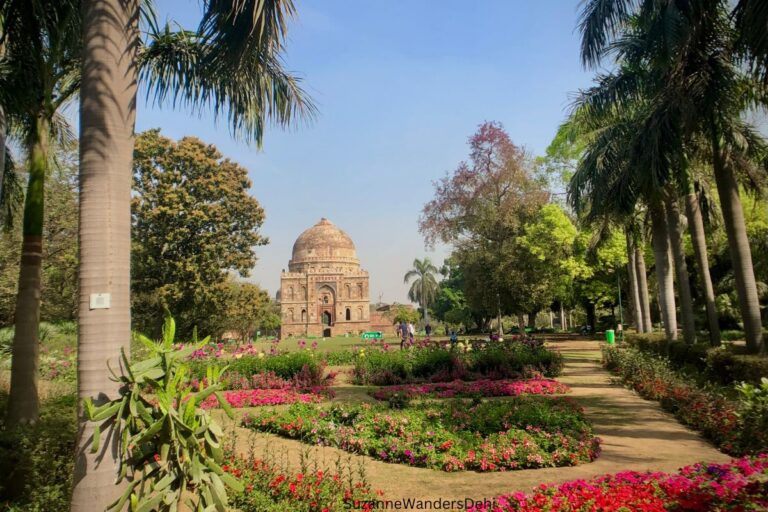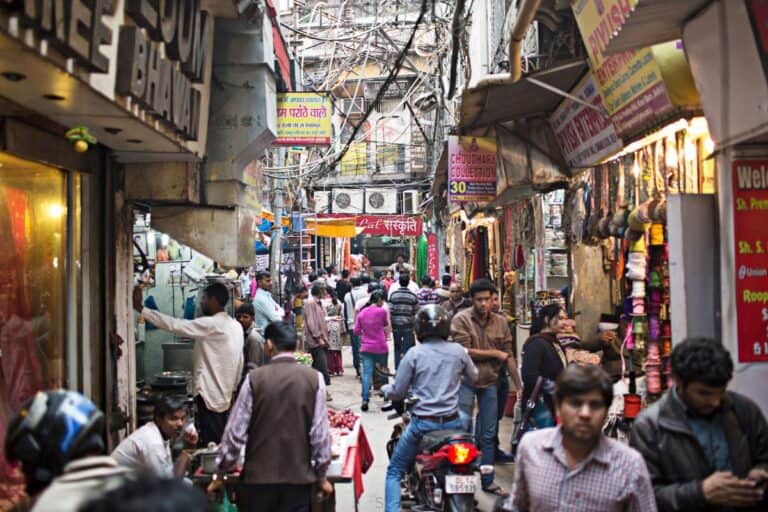29 Amazing Things To Do in Delhi by a Local (2025)

There is so much to do and see in Delhi it can be overwhelming. Delhi is full on bonkers and sensory overload all the time. I’ve lived in Delhi since 2020 and have narrowed it down to 29 of the most amazing things to do. I havepersonally visited all of these places – some of them many times!
In this guide I’m going to tell you how to get to each site, and make suggestions about where to eat and what other things you can do nearby. Delhi is a massive city and it makes sense to explore one part of the city at a time.
If it’s your first trip to Delhi, read my guide and suggested itineraries for first time visitors.
Short on time? Here are my top 3 picks:
Qutub Minar (UNESCO) – amazing complex of Islamic ruins built on the site of earlier Hindu temples
Lodhi Garden – beautiful park with tombs and mausoleums dating as far back as 1444, amidst a wide range of flora and fauna
Chandni Chowk – historic street in Old Delhi with iconic temples, mosques, markets and food stand
29 Amazing Things to do in Delhi by a Local
Like I said, Delhi is massive and there is so much to see. If your time is limited, pick the things that interest you the most, and then see other sites that are close by.
Delhi can be very hot; always bring water, a hat and sunscreen when heading out. As a woman, I always carry a dupatta or scarf to cover my head in case I end up in a gurudwara or mosque. If you’re visiting Delhi in winter, you’ll need a warm sweater or light coat.
1. Red Fort (Lal Quila) – UNESCO World Heritage Site
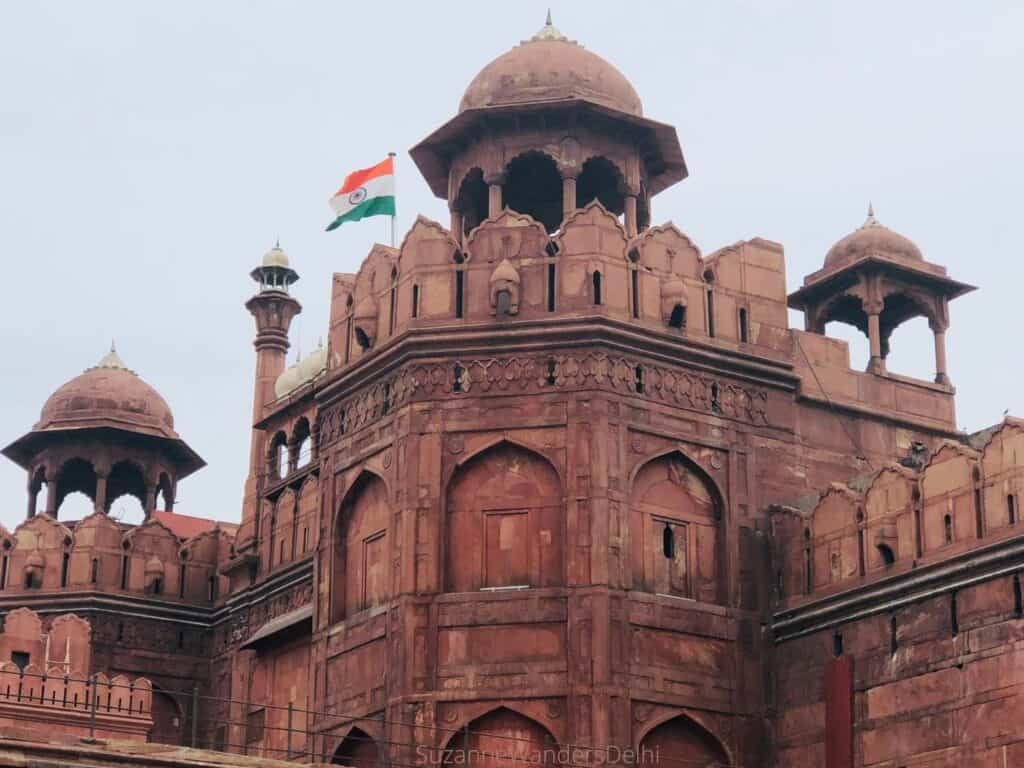
One of the most visited and magnificent sites in Delhi, the Red Fort has become a symbol of India’s independence from British rule. Every year on Independence Day the Prime Minister of India raises the flag from the Lahori Gate of the Fort and addresses the nation.
The Red Fort was built by Shah Jahan (the same ruler who built the Taj Mahal) in 1639. It remained the main residence of all successive Mughal rulers until the British imprisoned and then ousted the last Mughal ruler in 1857.
Another way to see the Red Fort is to attend the sound and light show called Jai Hind. It’s one hour and takes place at 3 different historic sites at the fort. The English show is at 8:30 pm, Tuesday to Friday. Tickets can be purchased at BookMyShow.
- Hours & Cost: 8:00 am – 9:00 pm, daily (closed Monday); INR 600 foreigners, children under 15 free
- Nearest metro station: Lal Quila (Violet line), exit Gate 4
- What to see nearby: Jama Masjid, Chandni Chowk, Khari Baoli
- Where to eat: Cafe Delhi Heights or Jugmug Thela (both in the Red Fort), street food on Chandni Chowk (how to safely eat street food)
👍 Insider tip: If you are visiting around August 15th (Independence Day), make sure the Red Fort is not closed. It usually closes to visitors about 10 days before in preparation for the Prime Minister’s address to the nation from the fort.
2. Qutub Minar – UNESCO World Heritage Site
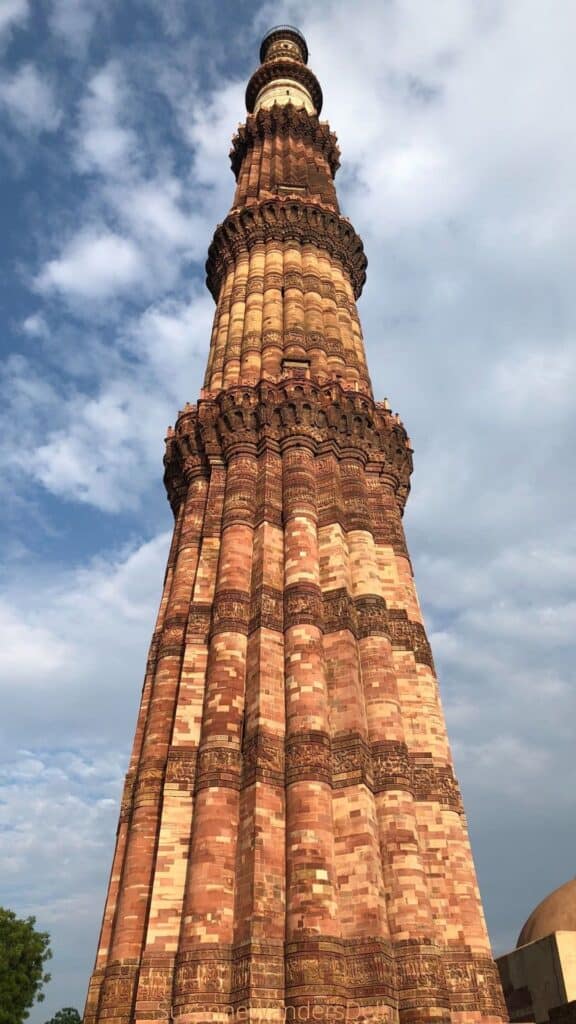
The Qutub Minar is the tallest brick minaret in the world, and part of a whole complex of historic sites. It’s one of my favourite places in Delhi, and I have been many times.
You can walk through the ruins of a madrassa, a mosque, tombs of past emperors, an unfinished minaret, and of course see the mysterious iron pillar that has never rusted. Some of the ruins date back to 1192 and are considered wonderful examples of Indo-Islamic-Afghan architecture.
- Hours & Cost: 9:00 am – 8:00 pm, daily; INR 600 foreigners, children under 15 free
- Nearest metro station: Saket (Yellow line), exit Gate 2
- What to see nearby: Mehrauli Archeological Park, Yogmaya Temple
- Where to eat: Dramz, Olive Bar & Kitchen, Chô
3. Jama Masjid
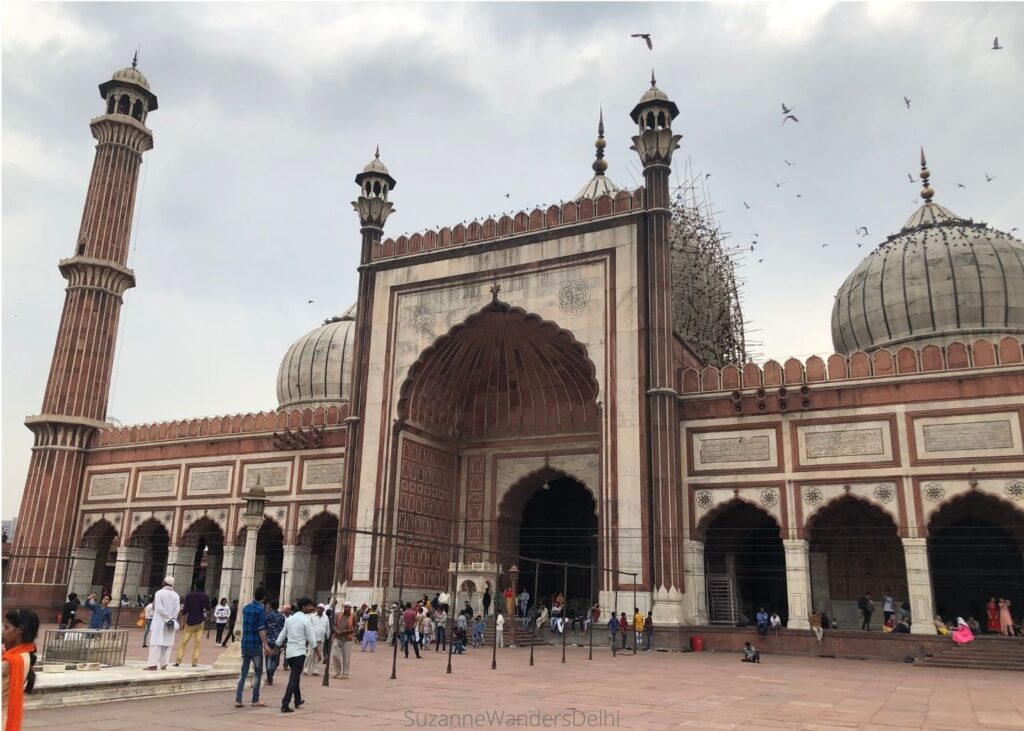
This is the largest mosque in Delhi, holding up to 25,000 worshipers at a time. Shah Jahan (the ruler who built the Taj Mahal) built the mosque in the 1650s for the royal family.
It is a beautiful structure with three gates, four towers and two minarets, all of red sandstone and marble. It is important to remember the Jama Masjid is a working mosque – visitor hours are restricted to allow for prayer times.
The Jama Masjid enforces a strict dress code. Both men and women should cover arms and legs, and women must also cover their heads. The mosque has sarongs available if needed. Don’t worry – many visitors end up having to cover up with a sarong, even men. I usually wear a kurta (Indian top) that falls almost to my knees, long pants and a dupata.
Before entering the mosque you must remove your shoes, but you can discretely carry them with you, or leave them outside with the shoe watcher. If you do leave them with the shoe watcher, he will expect a small tip, about INR 50.
For great views of Old Delhi (and a small fee) you can climb the towers, but be careful – they get congested and there have been reports of groping.
- Hours & Cost: 7:00 am – 12:00 pm & 1:30 pm – 6:30 pm, daily; free but there is a INR 300 fee for bringing in a camera
- Nearest metro station: Jama Masjid (Violet line), exit Gate 2
- What to see nearby: Red Fort, Kathika Cultural Centre, Chandni Chowk
- Where to eat: Karim’s, Ebony Cafe
👍 If you’re keen to eat street food while in Old Delhi, you can do a tour with this free self-guided Old Delhi Street food walk. Jama Masjid is next to Bazar Matia Mahal, which has lots of great Mughal style street food.
4. India Gate
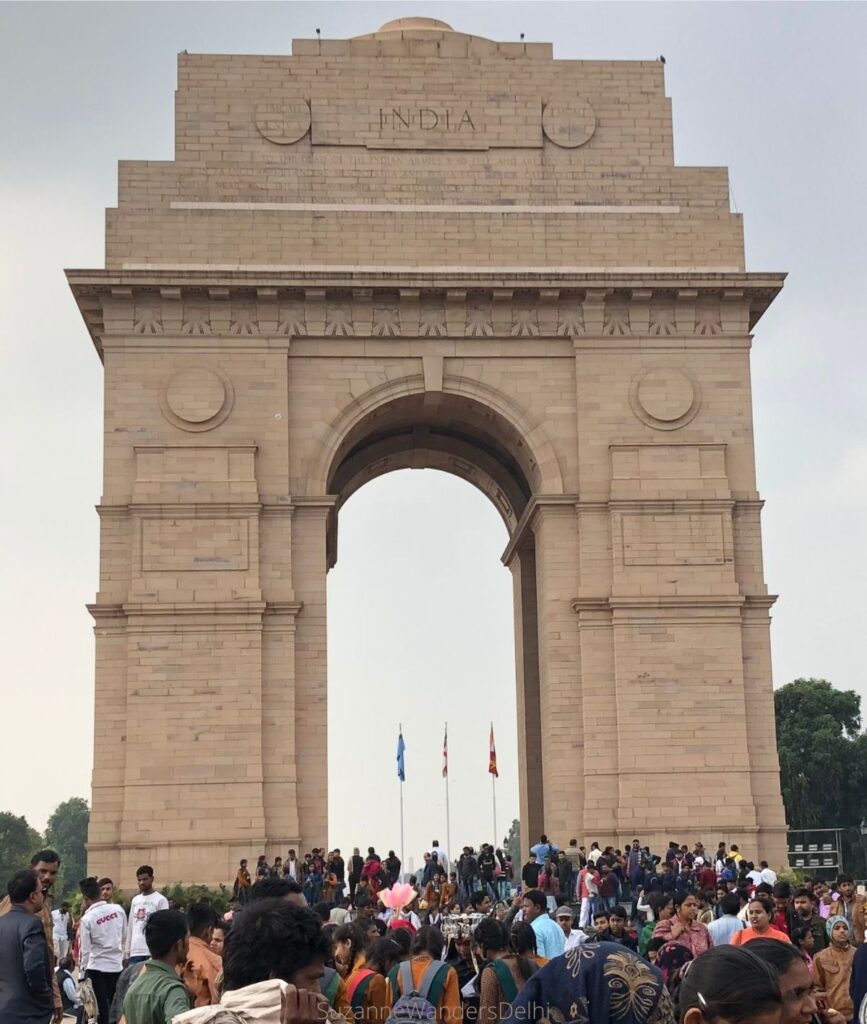
India Gate is a fantastic first stop for new visitors to Delhi. It’s a lively spot and very popular with locals. There’s always street vendors, food stalls and guys willing to take your photo for a fee.
This is what I refer to as a ‘soft introduction’ to Delhi, and it’s close to other sights that fall under this category. Check out my perfect one day in Delhi itinerary which includes other ‘soft introduction’ spots!
India Gate is a war memorial and has become a symbol of the city. It’s dedicated to the soldiers who lost their lives in the WWI and the Anglo-Afghan war of 1919. An eternal flame burns day and night to remind the nation of the lives lost.
The design was inspired by the Arc de Triomphe in Paris and it is beautifully lit up at night in the colours of the Indian flag.
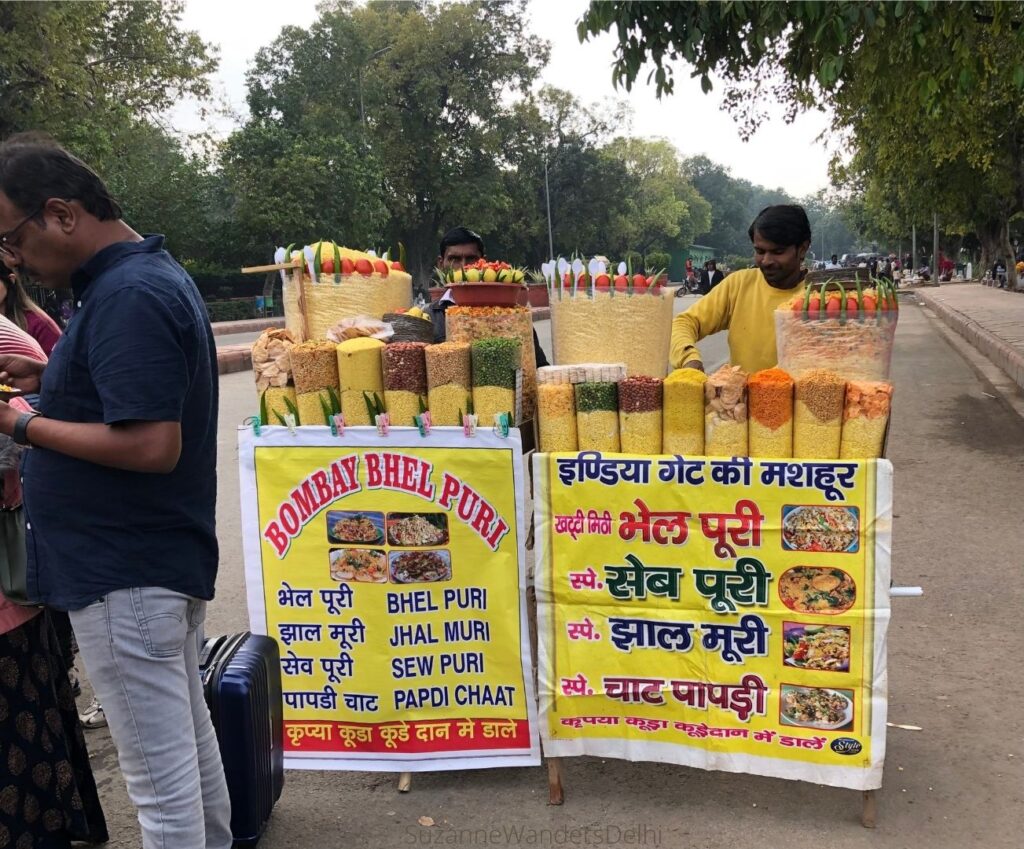
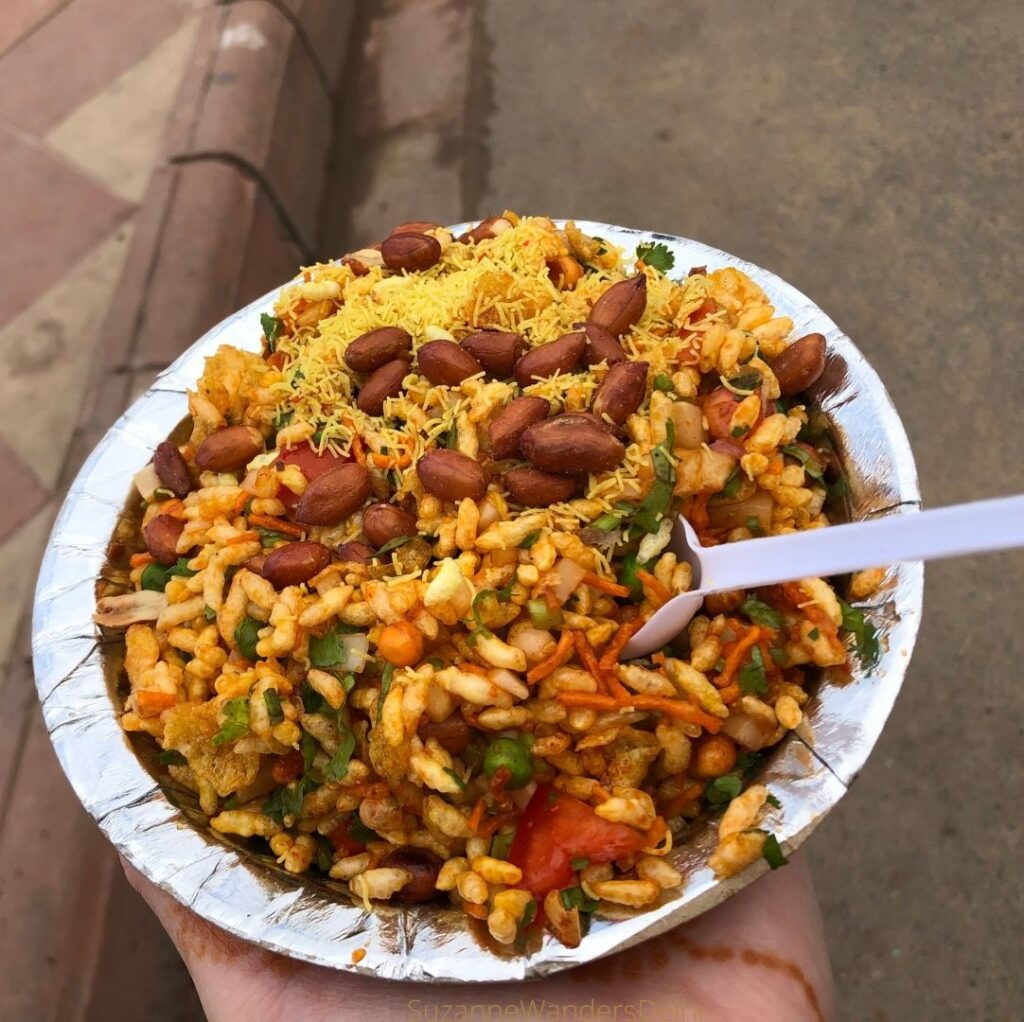
If you’re feeling energetic you can walk all the way up Kartavya Path, the boulevard that connects India Gate with Rashtrapati Bhavan (Presidential Palace) and see the famous government buildings.
- Hours & Cost: 7:00 am – 11:00 pm, daily; free
- Nearest metro station: Central Secretariat (Yellow line), exit Gate 3
- What to see nearby: Rashtrapati Bhavan, National Gallery of Modern Art, Bikaner House
- Where to eat: Haldiram’s and L’Opéra (both at Bikaner House), Andhra Pradesh Bhavan
5. Humayun’s Tomb – UNESCO World Heritage Site
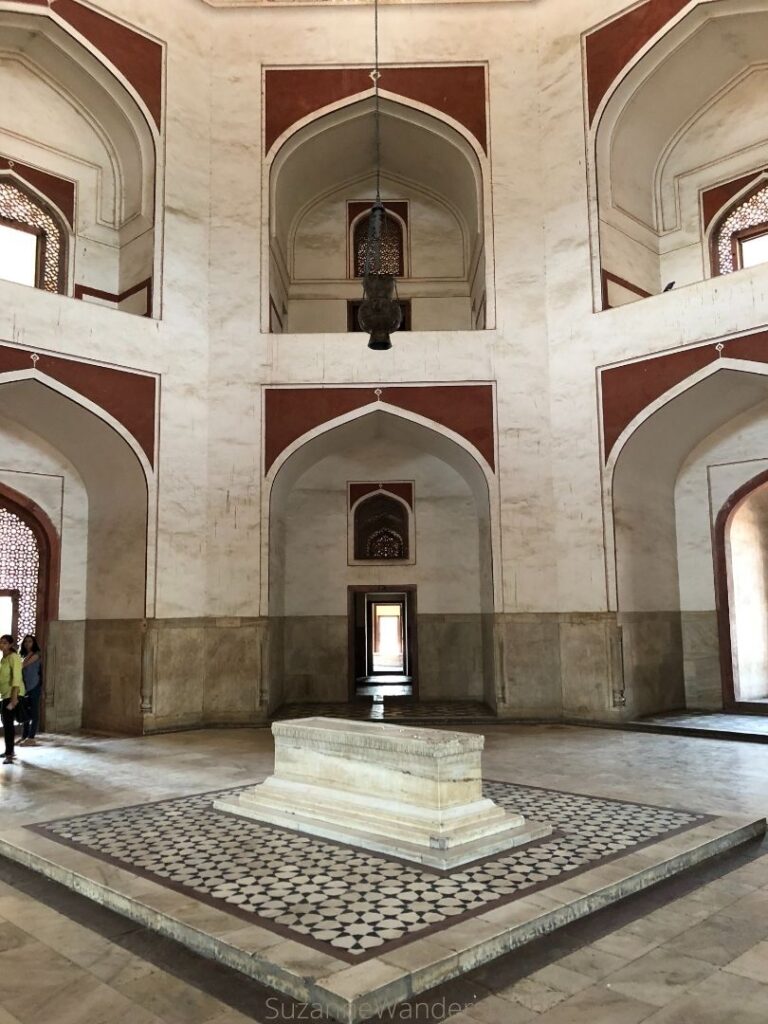
This gorgeous site will take your breath away. It was the first garden style tomb in India and inspired the design of the Taj Mahal. It’s a beautiful example of Mughal architecture and absolutely one of the most amazing things to do in Delhi.
There are several beautifully restored tombs in the complex, but the main one is that of Mughal ruler Humayun. Humayun was the great grandfather of Shan Jahan who built the Taj Mahal.
The tomb was commissioned by Humayun’s wife and chief consort, Bega Begum. Her grave is also in the tomb. Bega Begum oversaw the construction and financed it herself. It was finished in 1572.
Humayun’s Tomb is where the last Mughal ruler of Delhi, Bahadur Zafar, sought refuge during the Indian Rebellion of 1857. During Partition the tomb was used as a refugee camp for Muslims migrating to Pakistan.
- Hours & Cost: 8:00 am – 9:00 pm, daily; INR 600 foreigners, children under 15 free
- Nearest metro station: Jawaharlal Nehru Stadium aka JLN Stadium (Violet line), exit Gate 2 or 3
- What to see nearby: Sunder Nursery, Hazrat Nizamuddin Dargah, National Zoological Park
- Where to eat: Carnatic Cafe (in Sunder Nursery – you will have to pay the park entry fee, about INR 200 but the park is well worth seeing)
6. Swaminarayan Akshardham
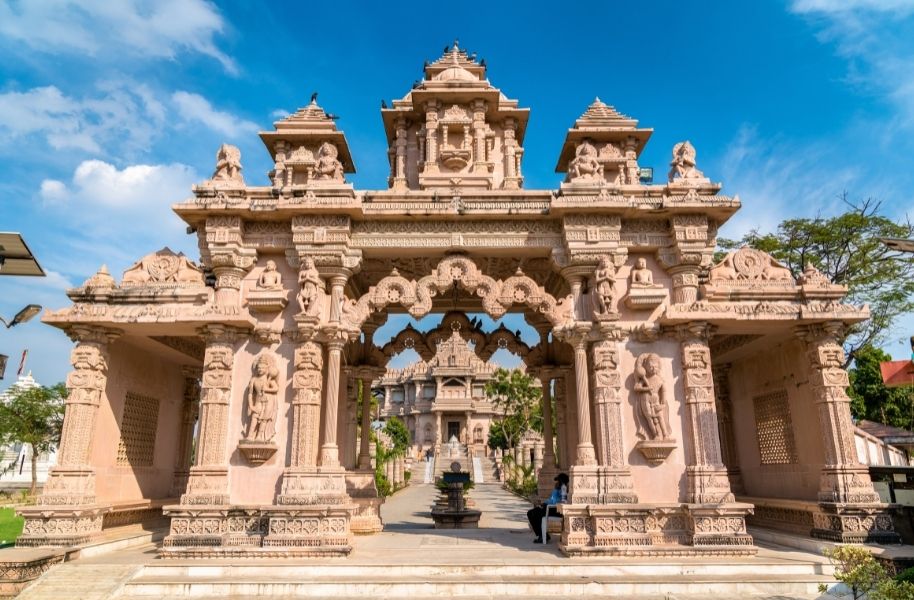
Akshardham Temple is one of the largest Hindu temples in the world. The temple is a stunning masterpiece of intricately carved marble from floor to ceiling. It is some of the most breathtaking architecture I have ever seen in India.
Besides the temple, visitors can see a giant screen movie on the life of the original Swaminarayan, take a cultural boat ride and view 3D dioramas. There’s a children’s play area, gift shop and massive food hall. It’s actually a very family-friendly temple.
There is a strict dress code at Akshardham; shoulders, chest and upper arms must be covered. Bottoms must be below the knee. Don’t worry if your outfit does not comply, the temple has sarongs available to borrow for a small refundable deposit. Photography is strictly prohibited, and you’ll have to leave all electronics at security.
- Hours & Cost: 10:00 am – 7:00 pm, daily (closed Monday); free but there is a fee for the exhibitions
- Nearest metro station: Akshardham (Blue line), exit Gate 1
- What to see nearby: Worlds of Wonder, Okhla Bird Sanctuary
- Where to eat: the cafeteria at Akshardham, Haldiram’s at Parsvnath Mall (where the Akshardham metro is located)
👍 Insider Tip: Every evening there’s a multimedia water which is extremely popular with locals. The show always tells a story from a Hindu holy text. It starts at 7:00 pm, but you have to be there 30 minutes before.
7. Bahai Lotus Temple
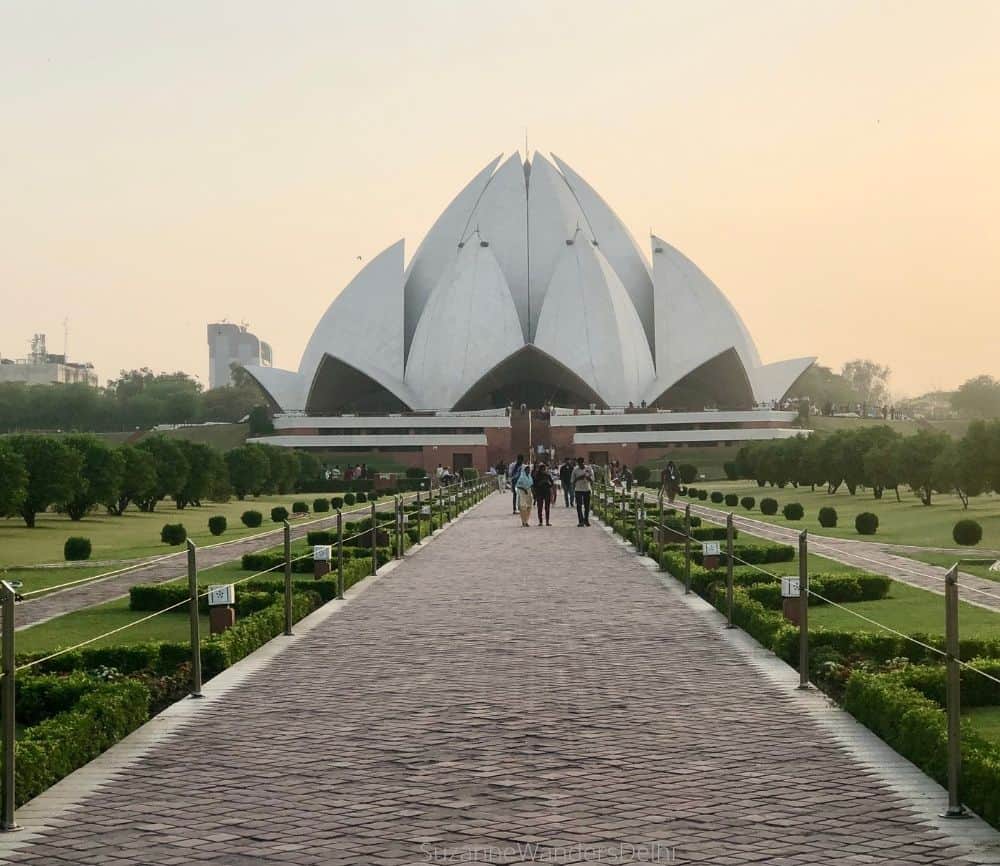
This beautiful temple is one of the most visited religious buildings in the world, and has won many awards for its unique architecture. It looks like a lotus flower with twenty-seven petals, and is built entirely of white marble.
You don’t need to be Bahai to visit – all faiths are welcome. In fact, every time I visit it’s full of Indians, the majority of which are Hindu.
The Lotus Temple is one of the most peaceful places in Delhi. Sitting quietly in the prayer hall is a very calming experience.
The temple gets busy on weekends and holidays, and the lineup can take an hour. The best time to go is in the morning. You will need to remove your shoes before entering the temple, and place them in the bags provided. Photography is not allowed inside the temple without prior permission.
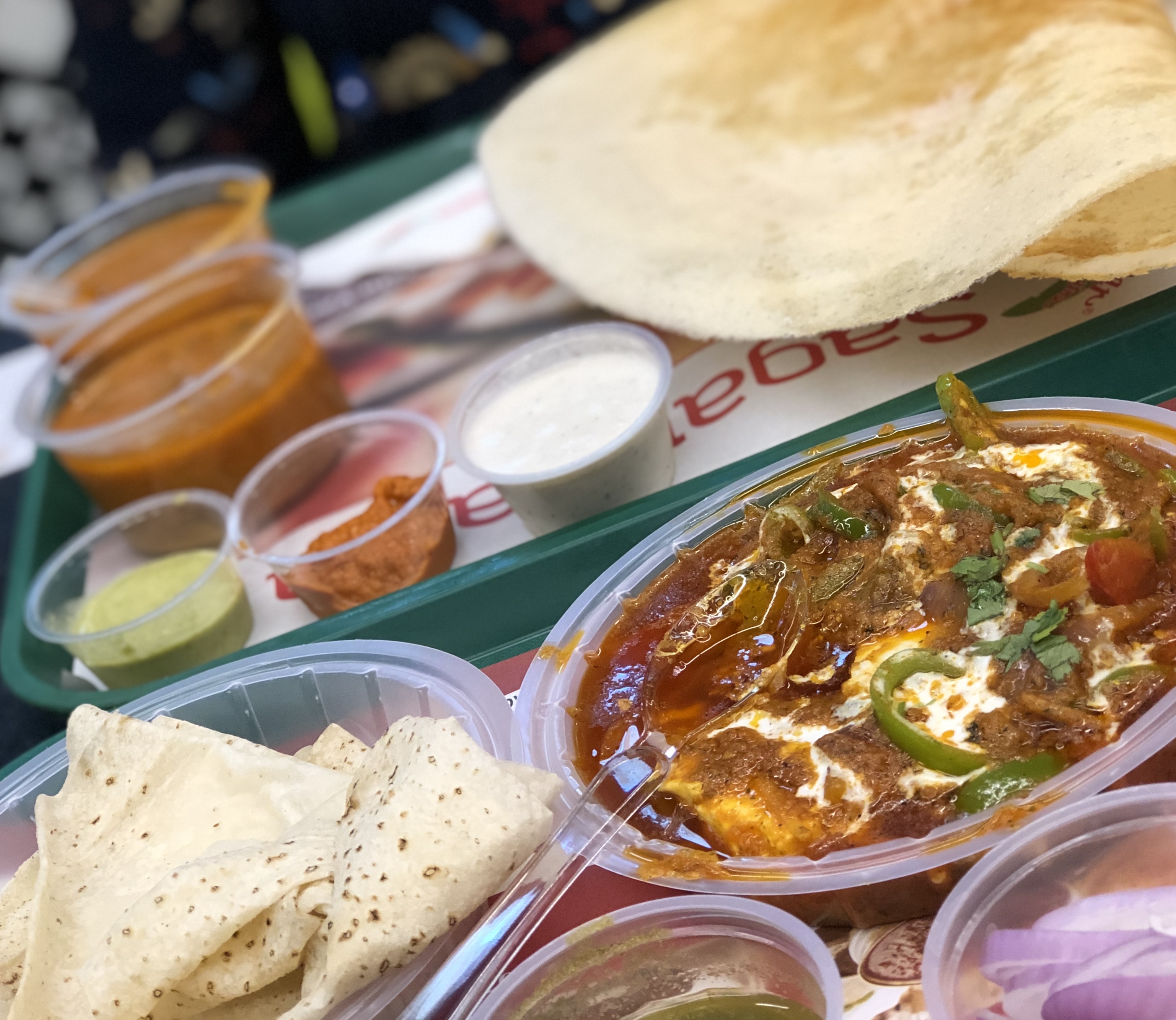
- Hours & Cost: 8:30 am – 5:00, daily (closed Monday); free
- Nearest metro station: Kalkaji Mandir (Violet or Magenta line), exit Gate 1or 2
- What to see nearby: ISKCON Hare Krishna Temple, Central Market Lajpat Nagar
- Where to eat: Epicuria Food Mall (many restaurants and a food court)
8. Dilli Haat INA
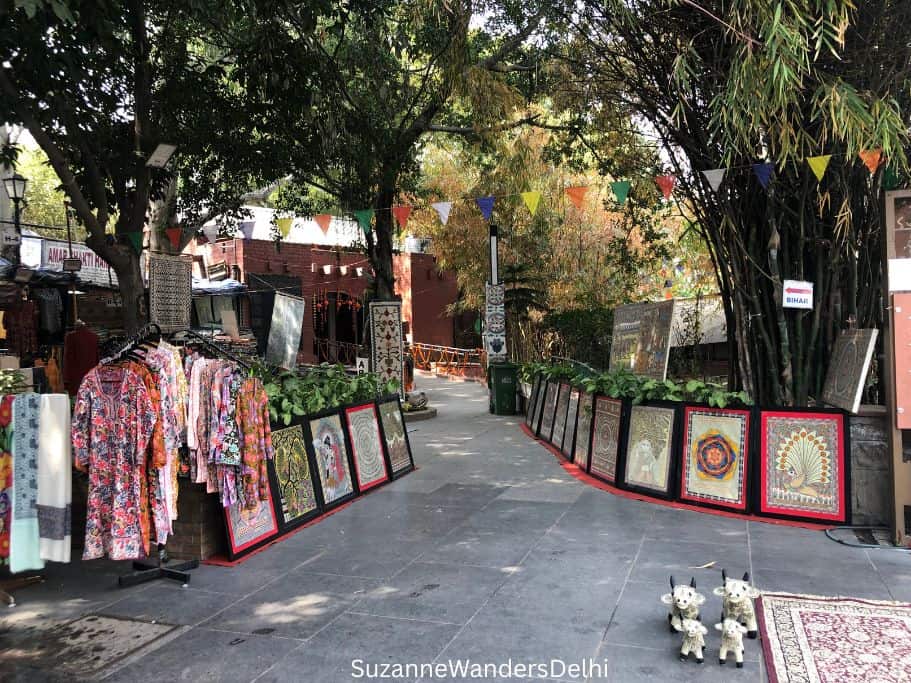
This is a one-stop shop for Indian handicrafts from all around the country. Artisans and craftsmen change every two weeks and the variety of crafts, arts and textiles is excellent.
If you are looking for souvenirs or gifts for people back home, this is a great place to shop.
Prices may be slightly higher than in the local markets, but given the convenience of having everything in one place and being able to shop in a relatively calm and traffic free environment, I think it’s worth it.
There is also a massive outdoor food court with stalls from many different states of India.
👍 Important: There are 3 Dilli Haat markets in Delhi. Make sure you go to the INA location. It is the largest and nicest by far. There is also a Delhi Haat INA store in Saket – do not go there!
- Hours & Cost: 10:30 am – 10:00 pm, daily; INR 100
- Nearest metro station: Dilli Haat INA (Pink and Yellow lines), exit Gate 5
- What to see nearby: Sarojini Nagar Market, Kotla Mubarakpur Complex
- Where to eat: Dilli Haat food court
9. Connaught Place
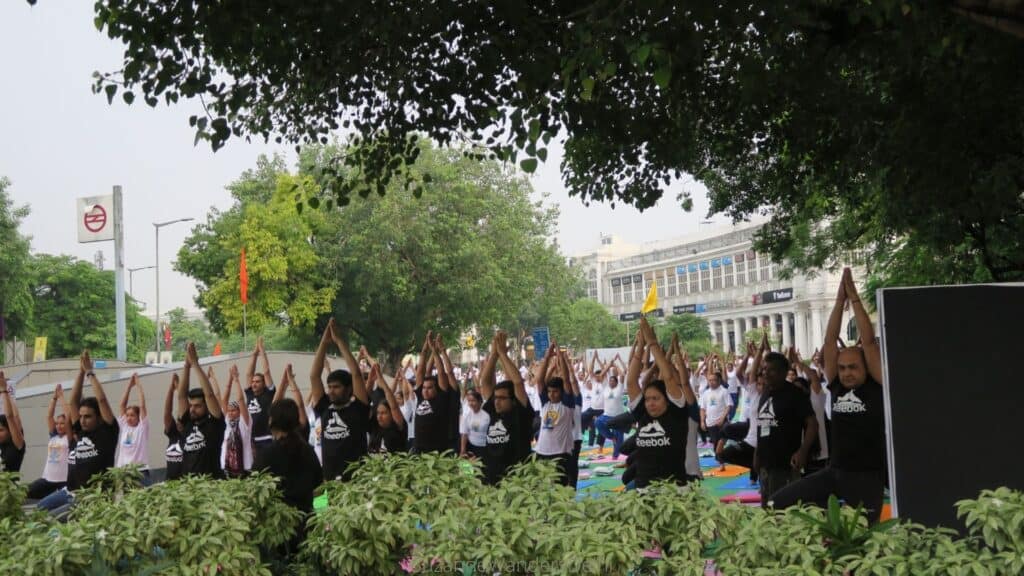
Built and designed by the British in 1929, Connaught Place is a large commercial and shopping hub with many restaurants, international and Indian stores, galleries, and money exchanges. There’s even a Museum of Illusions.
Known locally as CP, it is the unofficial centre of New Delhi and a favourite meeting and hang-out spot for locals and visitors.
CP is designed as a series of three concentric traffic and commercial circles surrounding a park and metro station. The inner circle is the main one with pleasant, colonnaded Georgian style buildings and covered walk ways. Street blocks are alphabetized, so it’s easy to navigate.
Some of my favourite places in CP are the unusual Charkha Museum with its 26 foot charkha, the Khadi store for Indian textiles, inexpensive food and ayurvedic beauty products, and the Odeon movie cinema.
Palika Bazaar
This is the bazaar underneath Connaught Place and my least favourite place to shop in Delhi. I find it slightly claustrophobic with it being below street level, and the vendors are relentless when they see a foreigner. If you decide to explore it, the entrance gate is near Block F of the inner circle of Connaught Place. You can also access it using exit Gate 6 at the Rajiv Chowk metro station.
- Hours & Cost: 10:00 am – 8:00 pm, daily (shop hours can vary); free
- Nearest metro station: Rajiv Chowk (Yellow or Blue line), exit Gate 2, 3, 4 or 5
- What to see nearby: Museum of Illusions, Janpath Market
- Where to eat: Zaffran, Pind Balluchi, street food in Connaught Place
👉 Thinking of taking a day tour while in Delhi? Book this tour that covers the most important sites!
10. Gandhi Memorial (Raj Ghat)
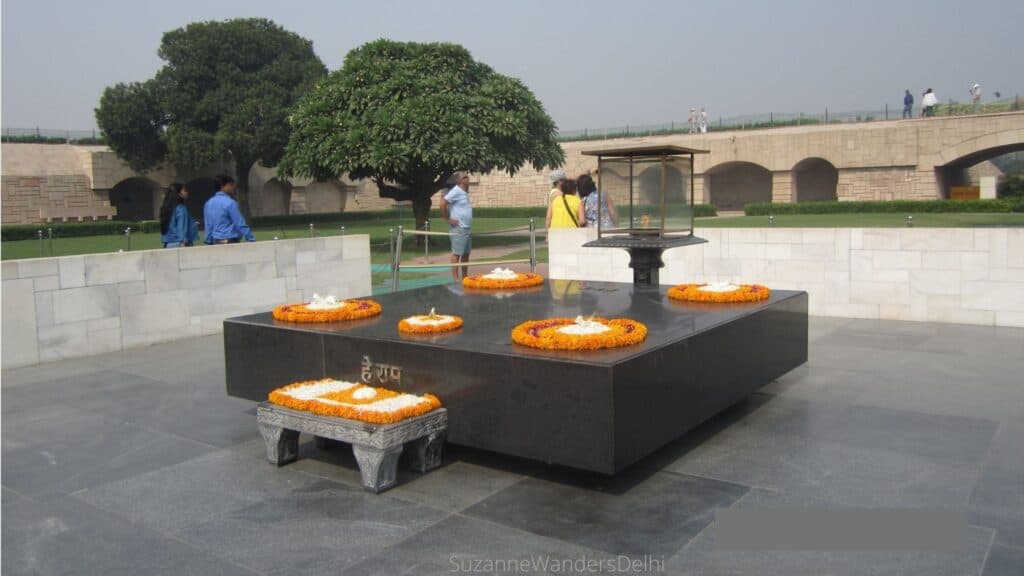
A list of things to do in Delhi is not complete without giving tribute to Gandhi, the father of the nation. This peaceful place is where Mahatma Gandhi’s last rites were performed, the day after his assassination on January 30, 1948.
Gandhi is still revered across India. His birthday, October 2nd, is a national holiday, his face is on the currency and his portrait still hangs in government offices.
The memorial itself is simple – a black marble platform meant to reflect the simplicity of Gandhi’s life. It is always adorned in flowers and an eternal flame. Before entering the site you will need to remove your shoes and place them in the storage area.
- Hours & Cost: 6:00 am – 6:00 pm, daily; free
- Nearest metro station: Delhi Gate (Violet line), exit Gate 4
- What to see nearby: Gandhi Darshan, National Gandhi Museum and Library
- Where to eat: Udupi Cafe
11. Gurudwara Bangla Sahib
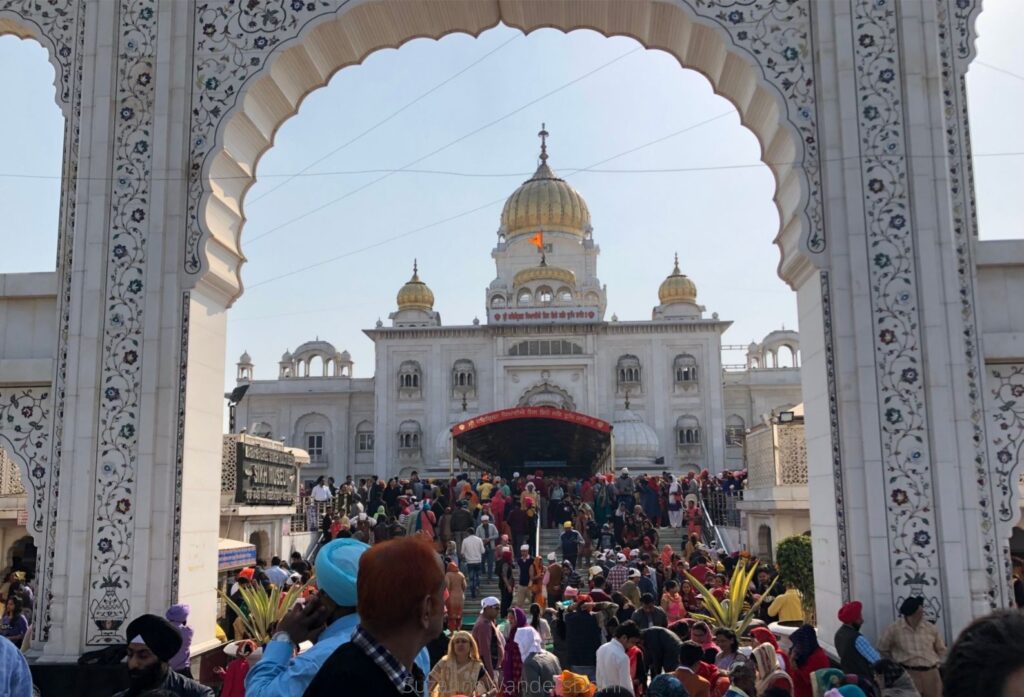
Gurudwara Bangla Sahib is the most prominent gurudwara (Sikh temple) in Delhi. Given its beauty and central location, it’s also popular with visitors. One of my Delhi apartments was owned by a Sikh family and I often went to this gurudwara with my landlady.
The Sikh faith is very welcoming and people of all different religions, races and nationalities are welcome. Everyone must cover their heads and remove shoes before entering. Bandanas are available to borrow. There are two secure shoe storage areas. You should dress modestly.
Things to do at Bangla Sahib
- listen to live devotional music in the prayer hall
- walk around the Sarovar (the large pool of water), believed to have healing powers
- visit the museum and gallery
- have langar (free community meal)
- get prasad on your way out (blessed food – usually the Indian sweet, halva)
Eating Langar at Bangla Sahib
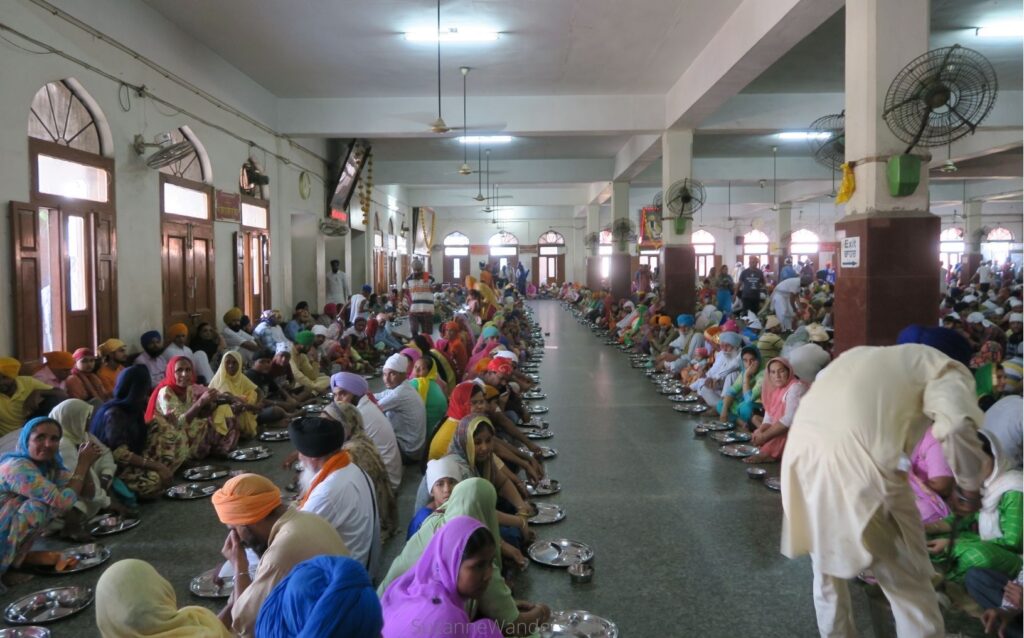
For a special experience, I recommend having langar at the temple. Langar is the free, vegetarian communal meal served in temples. You won’t see many foreigners doing this, but everyone is welcome regardless of faith or nationality. I am usually the only non Indian, but I’m always greeted with smiles and made to feel very welcome.
There are two langar halls at Bangla Sahib, but the main one is off to the side of the main prayer hall, just ask for directions if you can’t find it.
- Hours & Cost: 24/7; free
- Nearest metro station: Shivaji Stadium (Orange line), exit Gate 1
- What to see nearby: Sacred Heart Cathedral, State Emporiums on Baba Kharak Singh Road, Jantar Mantar
- Where to eat: langar at the temple, Coffee Home
👍 Insider tip: There is a visitors’ centre where you can leave your shoes and borrow a bandana. A volunteer can give you some background on Sikhism and the temple. Ask to see the communal kitchen where free meals are prepared for thousands each day – it’s very impressive!
12. Lodhi Garden
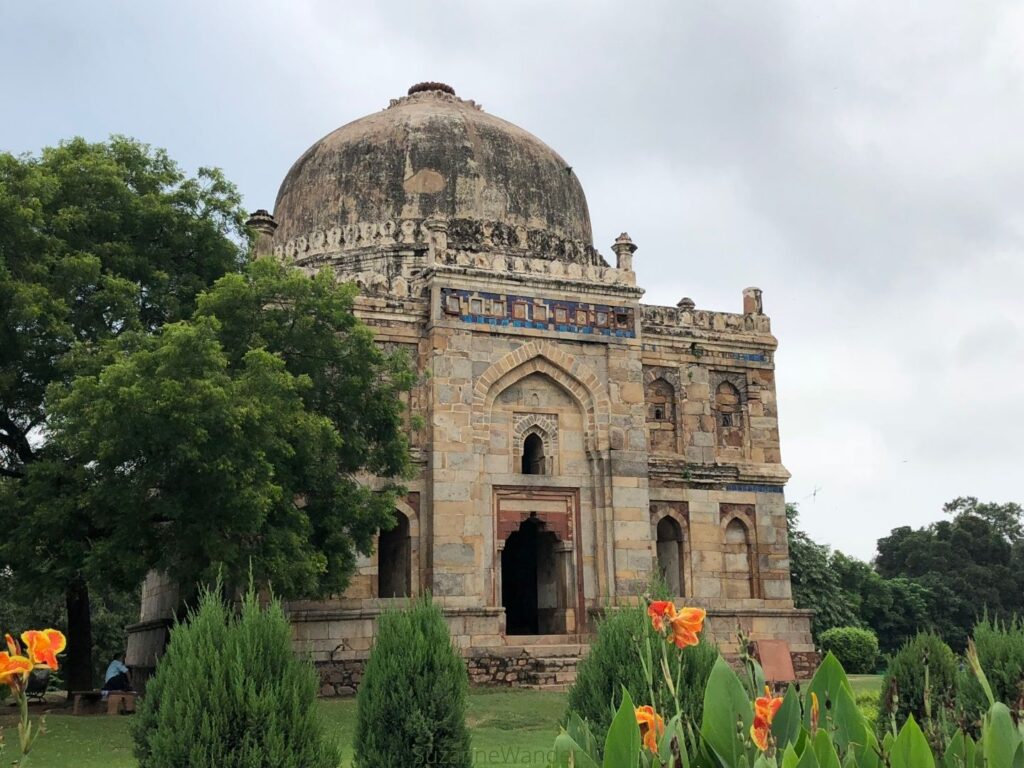
One of my most favourite things to do in Delhi is to visit Lodhi Garden. It is Delhi’s most captivating heritage park.
Stroll along the treed pathways and you will come across beautiful and well preserved tombs dating back to 1444 from the Sayyid and Lodhi dynasties. Also scattered in the park are the beautiful domed gateway of Bara Gumbad, a three domed mosque and the lovely Athpula bridge built by the Mughal ruler Akbar.
It is Delhi’s most popular park. On any given day you will see families with children, people picnicking, exercising and doing yoga by the pond and rose garden.
- Hours & Cost: 6:00 am – 7:30 pm, daily; free
- Nearest metro station: Jorbagh (Yellow line), exit Gate 2
- What to see nearby: Lodhi Art District, India Habitat Centre, Safdarjung Tomb
- Where to eat: Habiteria, Jamun, Jaatre Ice Cream
13. Tughlaqabad Fort
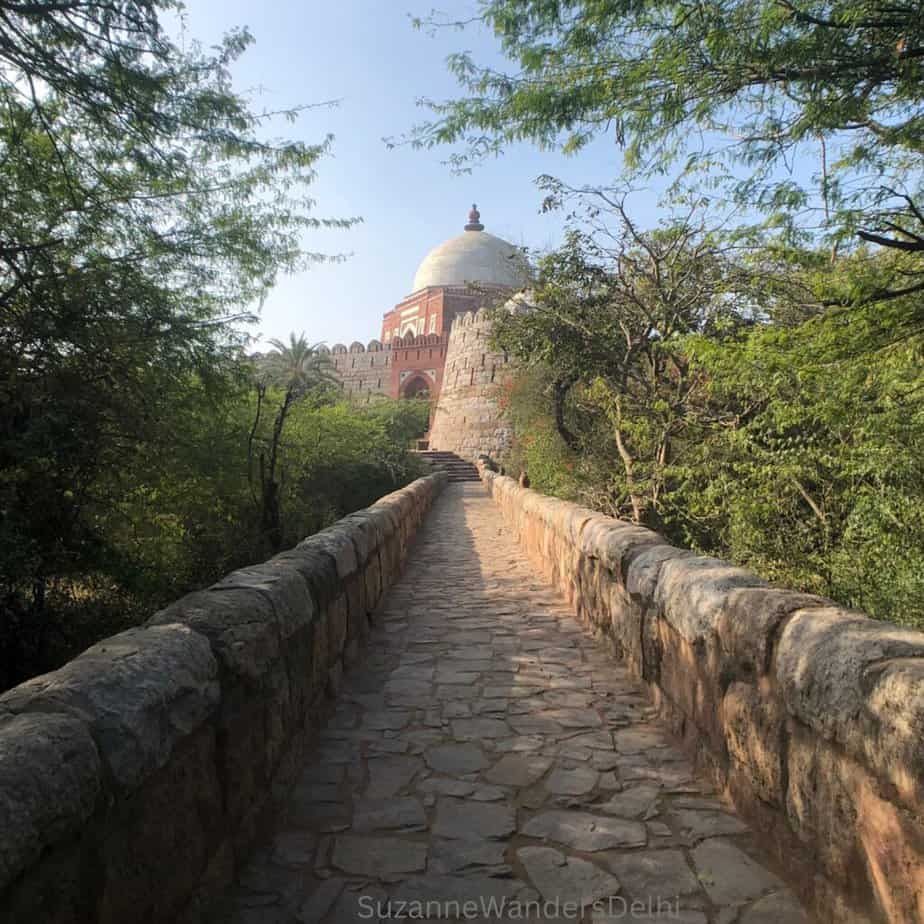
This is one historical sight that does not get the attention it deserves. The massive fort is steeped in legend, and even today believed to be cursed.
It was once a fortified city, and you can still see the stone fortifications from a higher vantage point within the fort. Thirteen gates remain intact as well as bastions, parapets, underground passages, towers and a massive stepwell.
The ruler Ghiyasuddin Tughlaq built the fort in 1321. He was in such a rush, he ordered all labourers in Delhi to work only on his fort. At the same time, the powerful Sufi saint Nizamuddin Auliya was having a stepwell built for his residence. Tughlaq’s order brought construction of Nizamuddin’s stepwell to a standstill, and Nizamuddin was furious. He cursed the ruler and the fort.
After Tughlaq’s murder (by his own son), the fort was abandoned. To this day, it languishes in ruin, while the tomb of Nizamuddin sees hundreds of visitors each day. Myth, curse, urban legend? Decide for yourself when you visit!
- Hours & Cost: 9:00 am – 6:00 pm, daily; INR 300, children under 15 free
- Nearest metro station: Govindpuri (Violet line), exit Gate 1
- What to see nearby: Adilabad Fort
- Where to eat: bring snacks and water because there aren’t any restaurants close by
👍 Insider tip: Go early to avoid the hottest part of the day, there isn’t much shade. It’s a good idea to buy your ticket in advance on the Archaeological Survey of India website (it’s also 50 INR cheaper). The entrance staff are not punctual and often don’t have change for ticket purchases.
14. Mehrauli Archeological Park
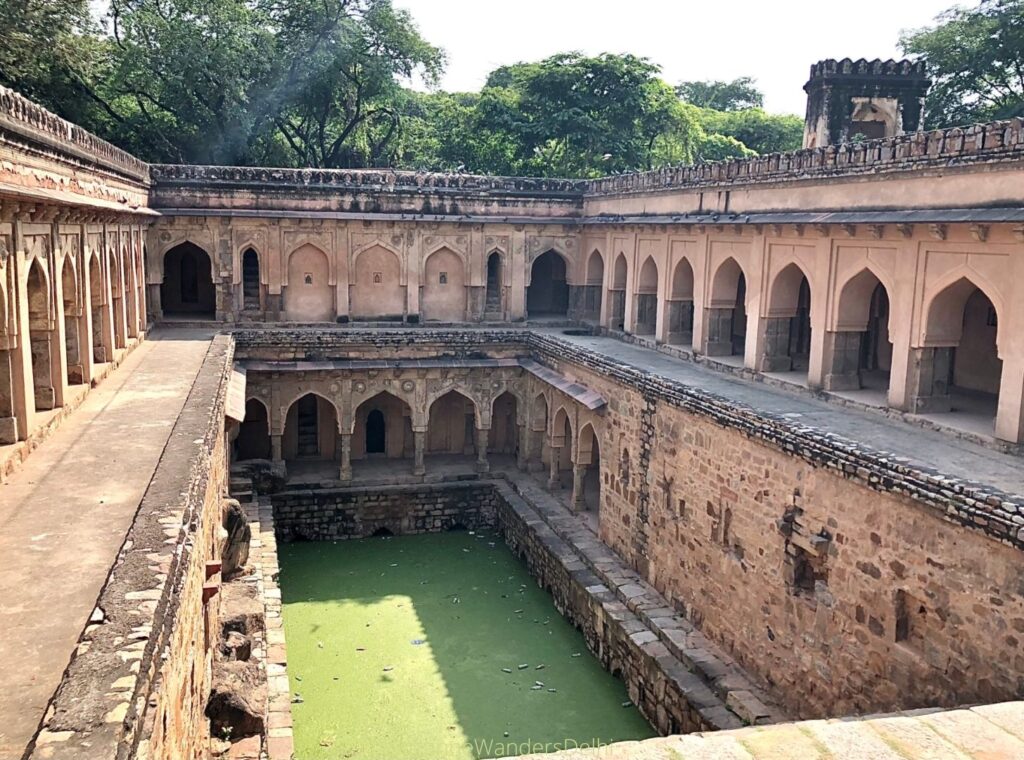
This is one of the most underrated things to do in Delhi. It boggles my mind that it is next door to one of the most popular sites in the city, the Qutub Minar, yet only receives a small fraction of the traffic.
Mehrauli Archeological Park is a large parkland, part forest, part gardens, with the most amazing ruins ranging from pre-Islamic to the late Mughal eras.
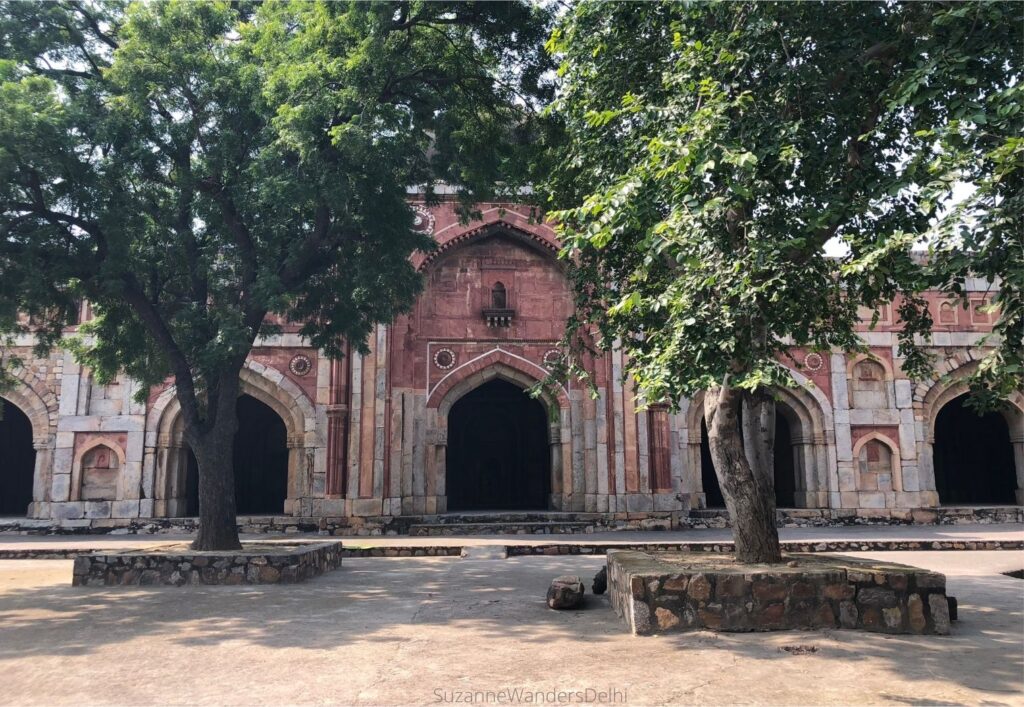
Make sure you visit the recently restored tomb of Quli Khan, Rajon ki Baoli (ancient stepwell), and Jamali Kamali mosque. Many parts of the park that were previously closed off are now open to the public, and it’s fantastic.
The park abuts the urban village of Mehrauli which also has some incredible, but mostly unprotected Mughal ruins. You will probably end up in Mehrauli as most of the paths end up at the back side of the urban village.
- Hours & Cost: 7:00 am – 7:00 pm, daily; INR 500 for foreigners
- Nearest metro station: Qutab Minar (Yellow line)
- What to see nearby: monuments of Mehrauli, Qutub Minar
- Where to eat: Cafe Stone (in the park)
15. Monuments in the Urban Village of Mehrauli
In many ways Mehrauli is a typical Delhi urban village. Narrow lanes, congested and noisy, predominantly Islamic. What makes this village so special are the magnificent and largely ignored historical structures. The ones you should see are:
Jahaz Mahal (Ship Palace)
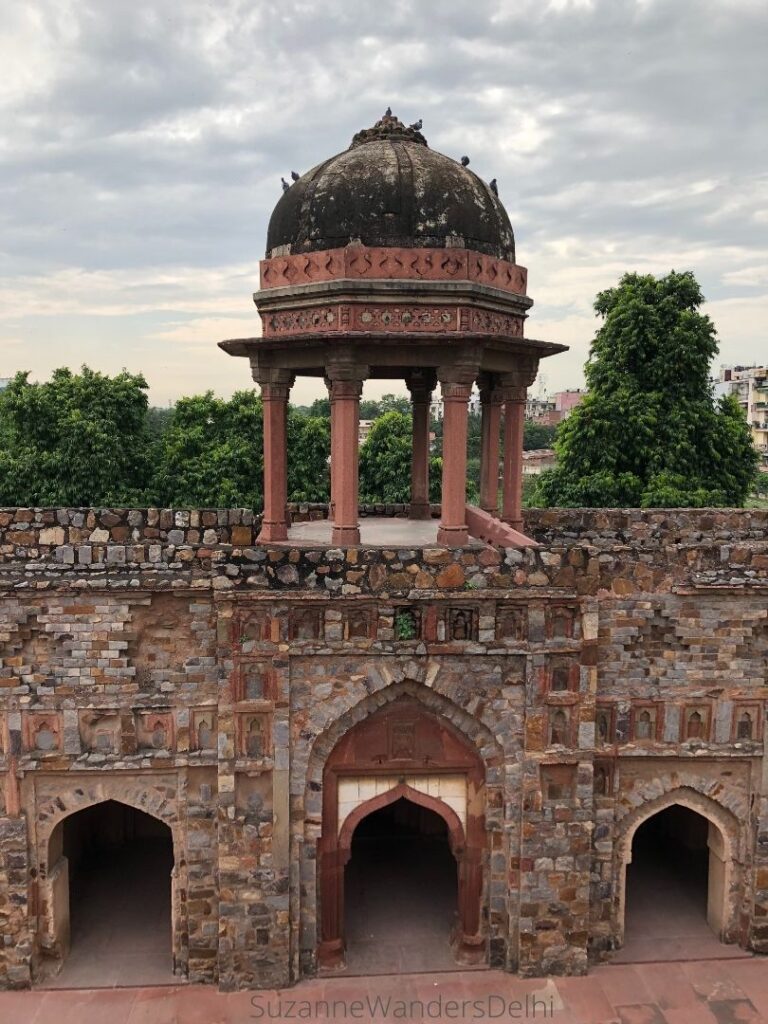
So named the Ship Palace because of its ship like reflection in the adjacent pool that once was there. It is another neglected monument dating back to the Lodhi dynasty, 1451-1526.
There is usually a caretaker here and if you tip him, he may let you up the locked stairs to get up to the roof.
Bhool Bhulaiya
The tomb of Adham Khan (a general and foster-brother to the Mughal ruler Akbar), is directly across the street from the busy Mehrauli bus station. Don’t be surprised if you see men playing cards and gambling.
Hirjon ka Khanqah
The sufi sanctuary holds the graves of 49 hijras (eunuchs), who once held esteemed positions in royal households. Remove your shoes, and women must cover their heads before entering. The entrance is an unmarked simple green gate flanked by a tiled door way.
Zafar Mahal
This is the summer palace of the last Mughal ruler, Bahadur Shah Zafar. You will know it by its huge wooden doors. If they are closed just crawl in through the opening. This once magnificent palace is crumbling away with new construction surrounding and even touching the boundary walls in some places.
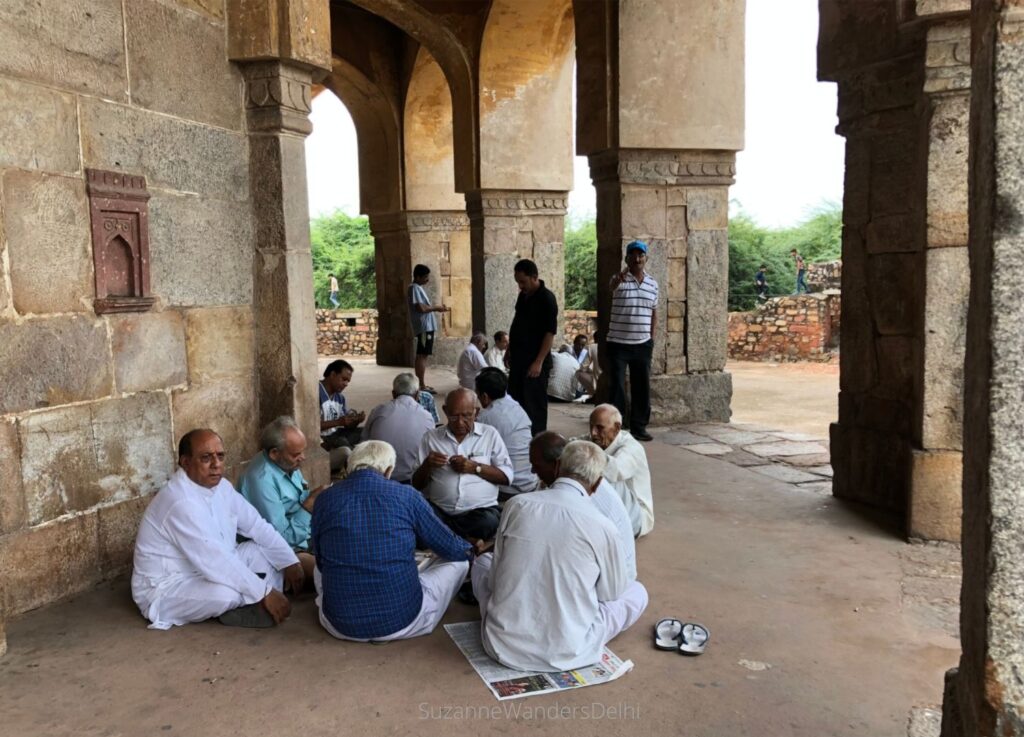
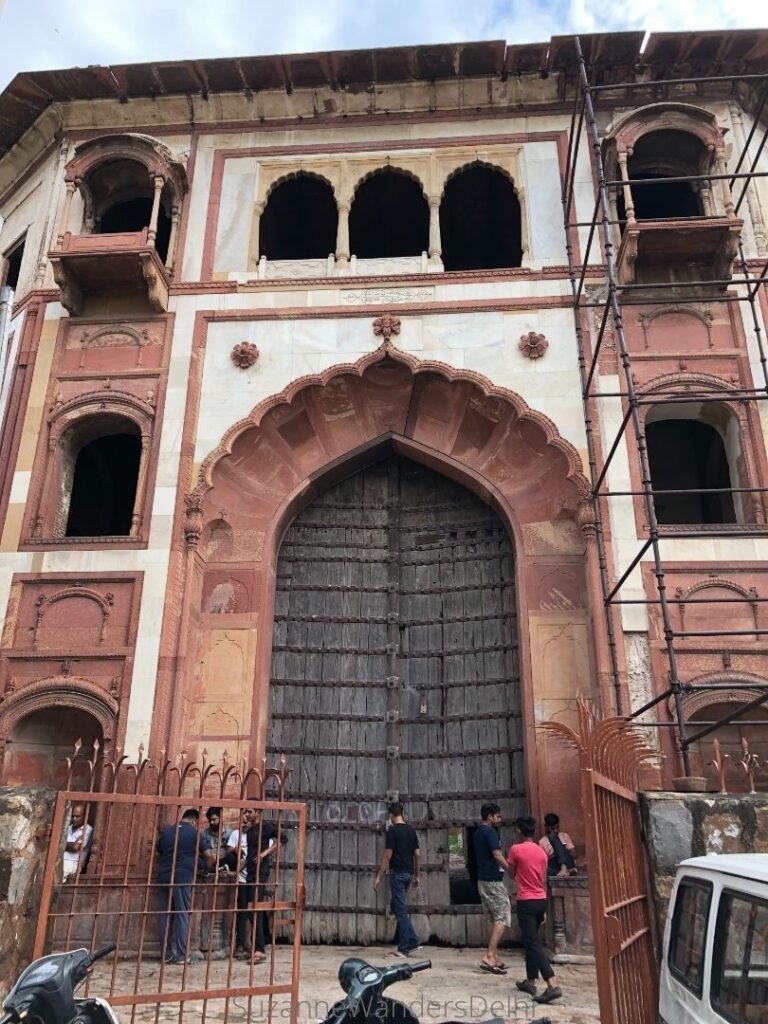
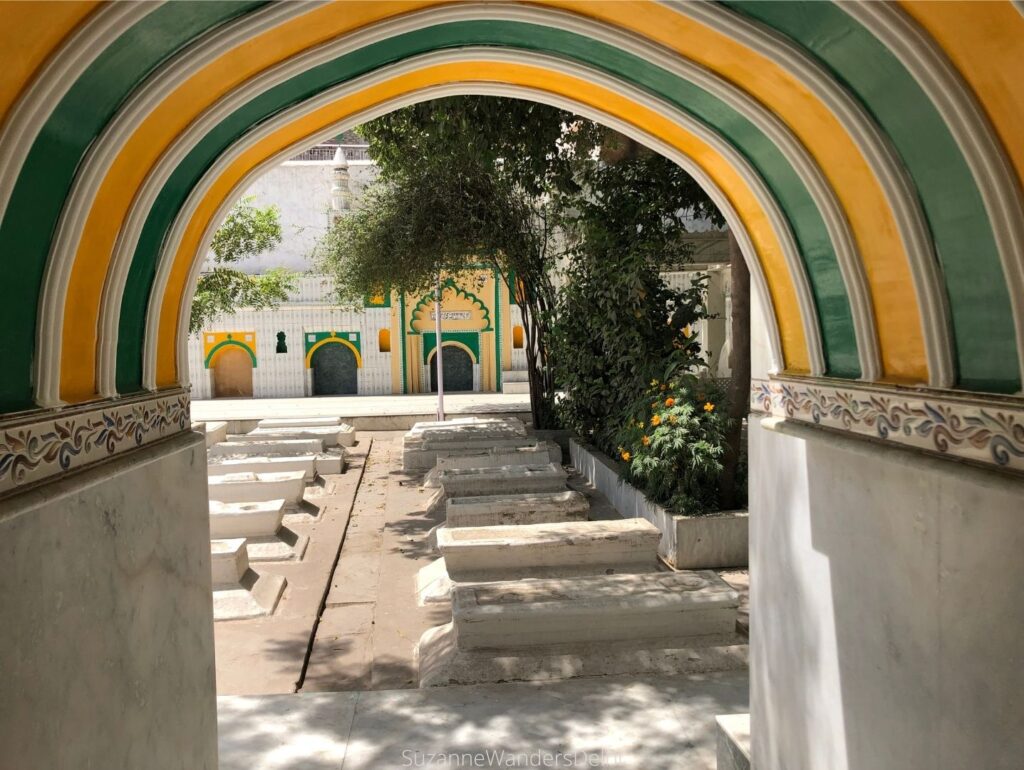
- Hours & Cost: 24/7 but go during the day; free,
- Nearest metro station: Chhattarpur (Yellow line), exit Gate 2
- What to see nearby: Qutub Minar, Champa Gali, Garden of Five Senses, Mehrauli Archeological Park
- Where to eat: Kathi Rolls on Kalka Das Marg
16. Hauz Khas Village
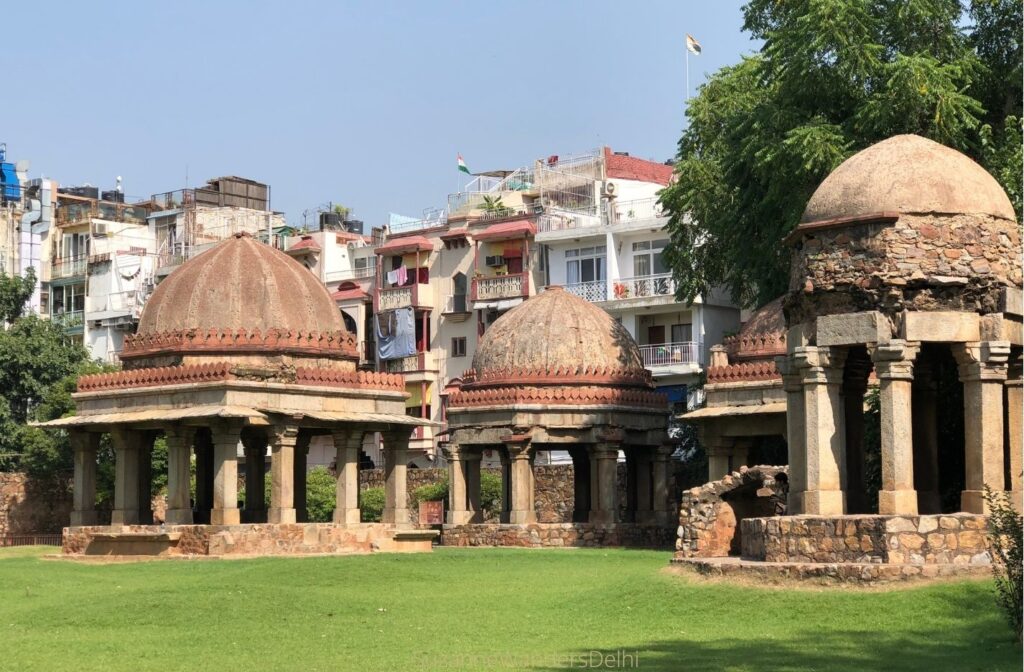
Hauz Khas Village is a pedestrian friendly, trendy urban village of winding lanes with shops, boutiques, restaurants and clubs. It is also home to the spectacular Hauz Khas Fort.
Only residents or business owners can drive within the village, so it’s easy to walk around and explore the laneways with their cafes and boutiques.
This is also a great spot to come at night if you want to experience the legendary Delhi night life.
Hauz Khas Fort
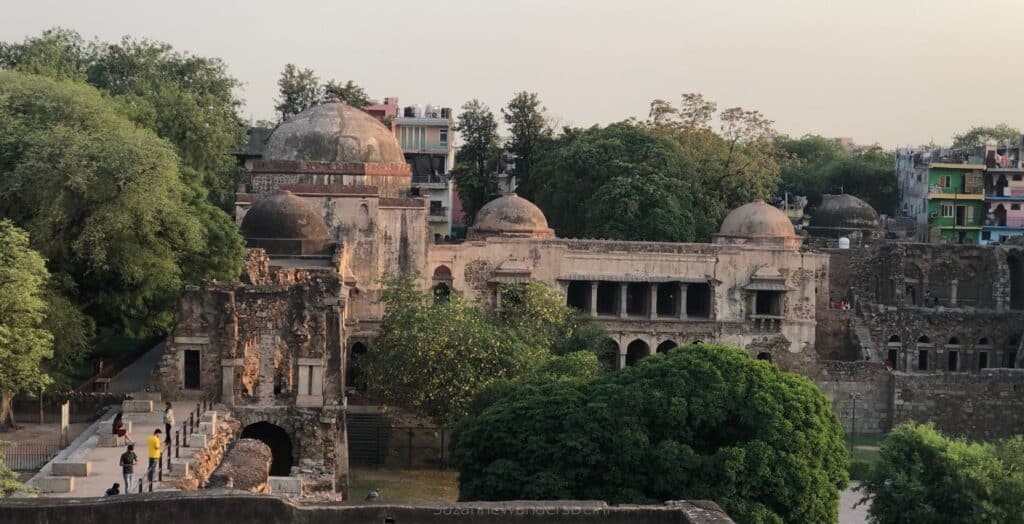
Take the time to see Hauz Khas Fort while you’re exploring the village. It’s very worthwhile. Follow the main lane to the end and you’ll see the entrance and pay booth.
The Fort was built in the 1300s as part of the second medieval city Siri. It’s open 7:00 am – 7:00 pm, daily but closed Sunday. Admission is INR 300 for foreigners.
- Hours & Cost: 24/7; free
- Nearest metro station: Green Park (Yellow line), exit Gate 4
- What to see nearby: tombs in Green Park, Jagannath Mandir, Deer Park
- Where to eat: Hauz Khas Social (try to get a seat on the outdoor terrace for great views of the Fort), Coast Cafe
👍 Important: Do not confuse the neighbourhood and market of Hauz Khas with Hauz Khas Village – they are different and 1.7 km apart. If taking a rickshaw to Hauz Khas Village, make sure you tell your driver you want the village.
17. Chandni Chowk (Old Delhi)
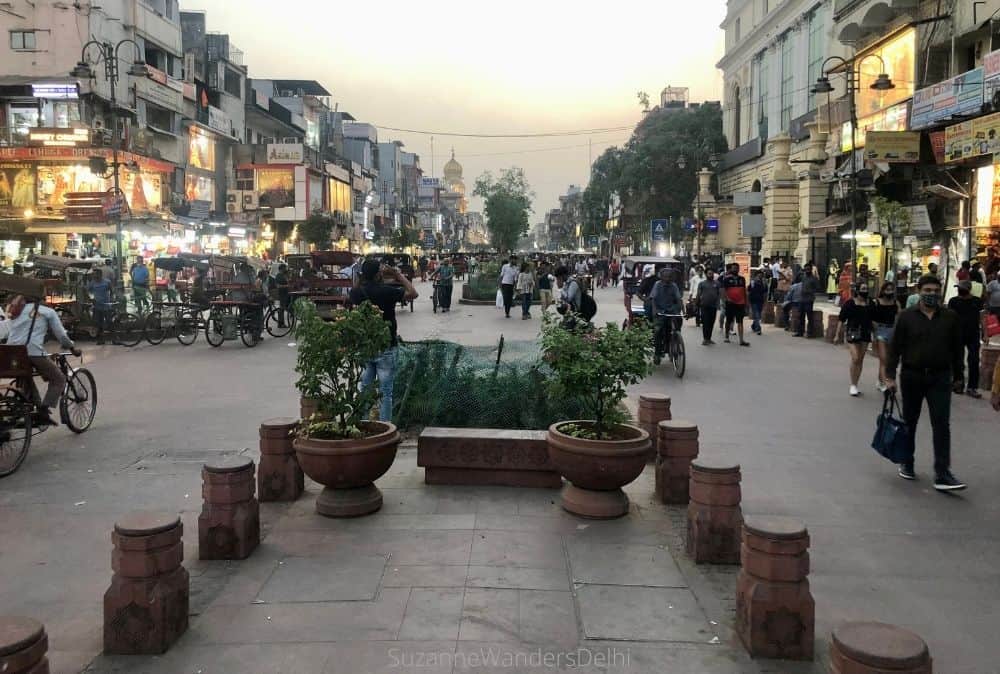
Welcome to Old Delhi! Chandni Chowk is one of the oldest streets in Delhi. This is where those iconic photos of Old Delhi with congested narrow lanes and jumbles of electric wires overhead were taken!
Chandni Chowk is the name of the main street that runs from the Red Fort to Fatehpuri Masjid, but it also refers to the neighbourhood and market area.
The street is a pedestrian friendly heritage zone between 9:00 am and 9:00 pm every day, so it’s easy to explore. Consider doing this free DIY heritage walk of Old Delhi to see all the area has to offer.
If you still want the thrill of exploring Old Delhi with all its craziness, venture off the main thoroughfare into the lanes and alleys.
Exploring the Lanes of Chandni Chowk
Chandni Chowk is famous for its specialty markets and historic sites. Here are a few, but if you want to explore the area in more depth, take a look at what to see in Old Delhi.
Paranthe Wali Gali – a lane filled with parantha shops (traditional flat bread) in every variety you can imagine. The only thing I don’t like about the paranthas here is they are fried in oil, but if that doesn’t bother you, go ahead and try one. They are delicious and fresh.
Khari Baoli – Asia’s largest wholesale spice market; you can also buy dried fruit and nuts here. Prices will be lower with vendors deeper in the lanes of the market.
Haveli Mirza Ghalib – the historical home of the last, and some say the greatest Mughal poet, Mirza Ghalib.
Dariba Kalan – the silver market
Kinari Bazaar –here you will find all kinds of wedding accessories, lace, ribbon, beads and just about every other embellishment for clothing.
Naughara Gali – a lane with 9 Jain havelis (mansions) with beautiful painted doors in Kinari Bazaar. The lane is a little hard to find but it’s off Kinari Bazaar Road, and there is a Jain temple at the end of the lane.
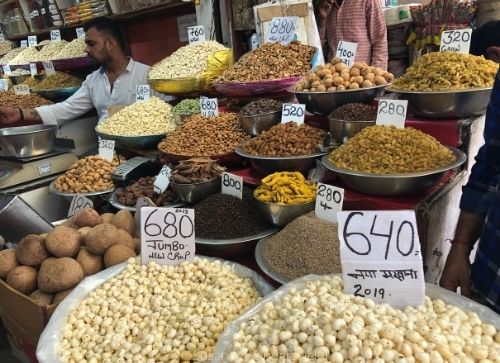
On the Heritage Road of Chandni Chowk
If you walk from one end of Chandni Chowk to the other, you will pass by these important sites:
The Red Fort, the royal Mughal palace built in the 1600s
Shri Digambar Jain Lal Mandir, the Jain temple and bird hospital. It is closed to visitors 12:00 pm – 6:00 pm so plan to go in the morning or after 6:00 pm.
Gurudwara Sis Ganj Sahib, the Sikh temple.
Town Hall, the historic building completed in 1863 used by the municipality of Delhi until 2009. The statue out front used to be Queen Victoria but after India’s independence it was changed.
Fatehpuri Masjid is a mosque built for Fatehpuri Begum in 1650, one of Shah Jahan’s wives. Shah Jahan is the Mughal ruler who built the Red Fort.
If you don’t feel like walking on Chandni Chowk, you can take a cycle rickshaw. Drivers charge a flat rate of INR 20/person, but they usually increase this for tourists.
- Hours & Cost: 24/7 but go during the day (shops are open 11:00 am – 8:00 pm and closed on Sunday); free
- Nearest metro station: Chandni Chowk (Yellow line), exit Gate 5
- What to see nearby: Jama Masjid, Partition Museum, Raj Ghat (Gandhi Memorial)
- Where to eat: Kake di Hatti, Asha Ram, Kanwarji Raj Kumar
👍 Insider tip: If you want to eat like the locals, order chole bhature from Kanwarji Raj Kumar on Chandni Chowk. The chole bhature is excellent! It’s just up the road from the temples on the same side of the street.
18. Eat Street Food
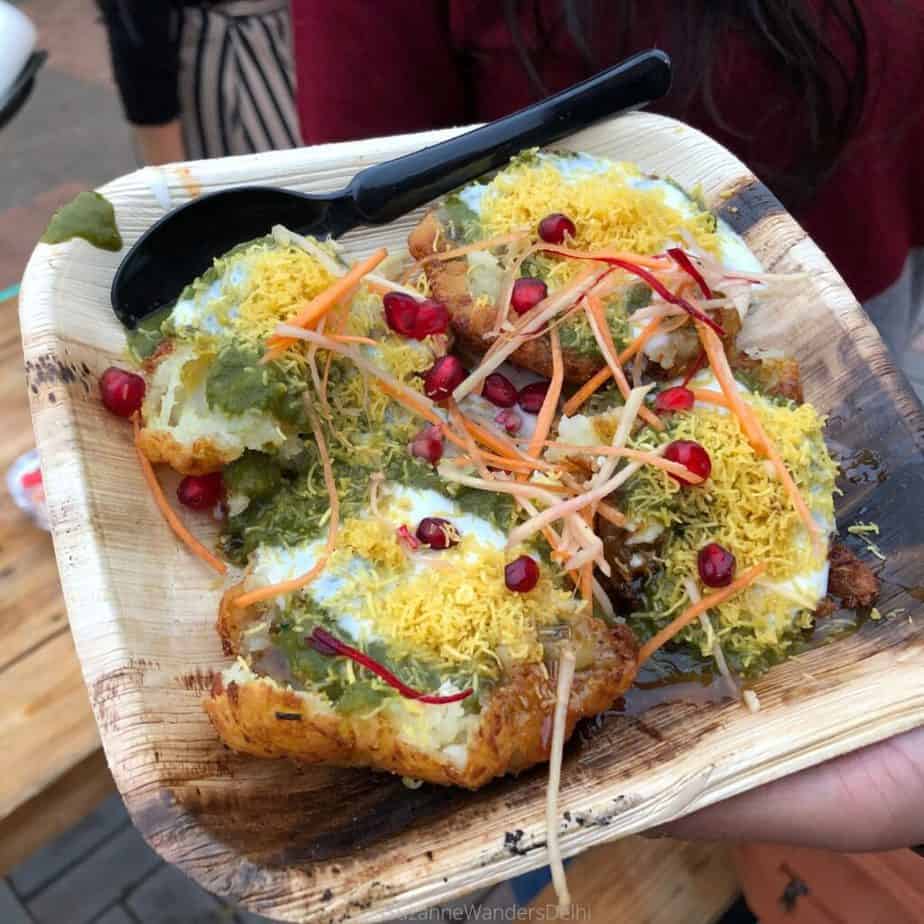
You have not fully experienced Delhi until you try the amazing street food. After all, Delhi is the food capital of India and it has a thriving street food scene. The variety and ingenuity of the vendors is outstanding.
Street food is literally everywhere. There are food stalls and stands in markets, outside metro stations, beside the sites and monuments, in parks and outside office buildings. Food is a big part of the culture of Delhi.
With some common sense and a few tips, you can safely eat street food and experience the city like a true Dilliwala! My top tips? Eat where the locals are eating, wash your hands first, and avoid unfiltered water and meat.
One way to sample the food and learn more about the area is to take a walking food tour. These are the two companies I recommend: Delhi Food Walks and A Chef’s Tour. But you don’t have to take a tour to enjoy the food. I give very specific recommendations in 3 Markets for Street Food that Aren’t in Old Delhi.
Eating at Haldiram’s is a Great Option

Haldiram’s is a great choice If you are worried about hygiene but still want to sample street food. They have a lot of typical street food dishes, including golgappa (the one thing I never eat on the street).
Everything is safe to eat at Haldiram’s and there are locations all across Delhi.
19. National Museum
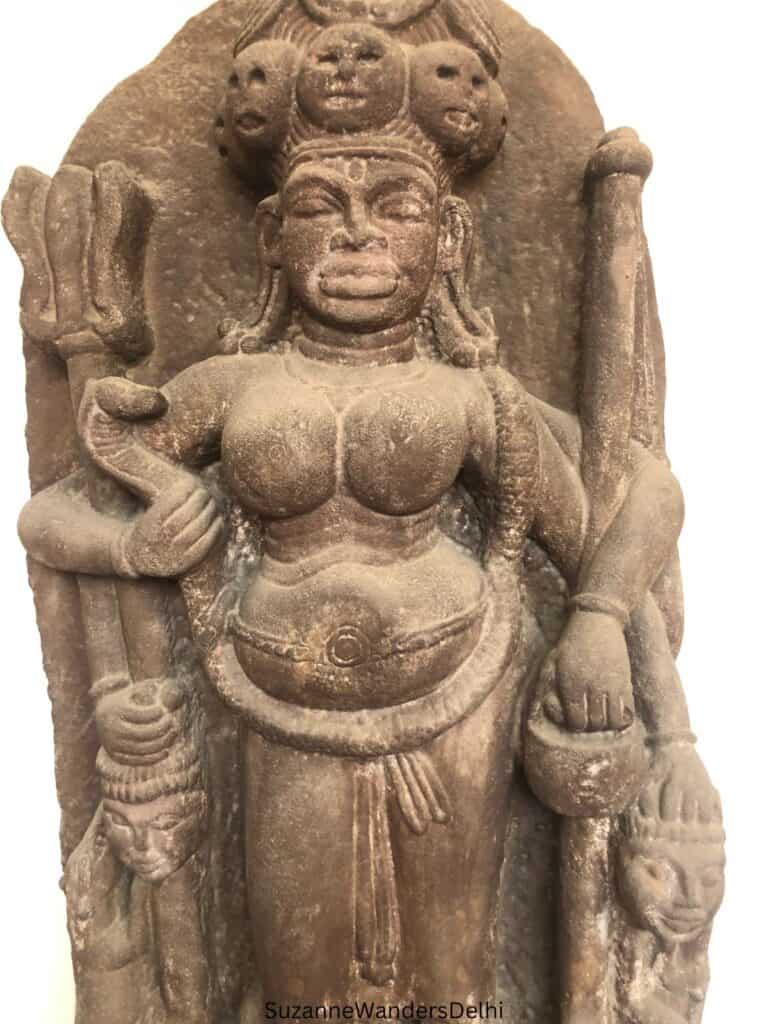
As far as national museums around the world go, Delhi’s National Museum is not the most spectacular, but it does have some very unique collections. The British removed the best Indian artefacts during the Raj, and you probably have a better chance of seeing them in London than Delhi.
However, the museum does have a couple of rare collections, and holds objects spanning 5,000 years of Indian art, jewelry, armour and coinage.
For history geeks, the world’s best collection of antiquities from the Indus Valley Civilization is here.
There is a very special collection of bone fragments from the Buddha, which were discovered in 1970. The museum’s Buddhist art section has actually become a pilgrimage site. Buddhist monks and the royal families of Thailand and Bhutan visit regularly to pray over the sacred relics. In fact, the Buddhist art collection is in a separate, quiet part of the museum that resembles a temple.
If you just want to view the highlights, the museum offers a free 90 minute guided tour at 10:30 am and 2:30 pm daily. On Saturday and Sunday there are extra guided tours at 11:30 am and 3:00 pm.
- Hours & Cost: 10:00 am – 6:00 pm (closed Monday); INR 500 foreigners, students up to grade 12 are free with ID
- Nearest metro station: Udyog Bhawan (Yellow line), exit Gate 2
- What to see nearby: India Gate, Rashtrapati Bhavan, Gandhi Smriti Museum
- Where to eat: Kafe@Museum (in the National Museum), Ba Ni Rasoi (in the Gujarati Bhavan)
20. National Gallery of Modern Art
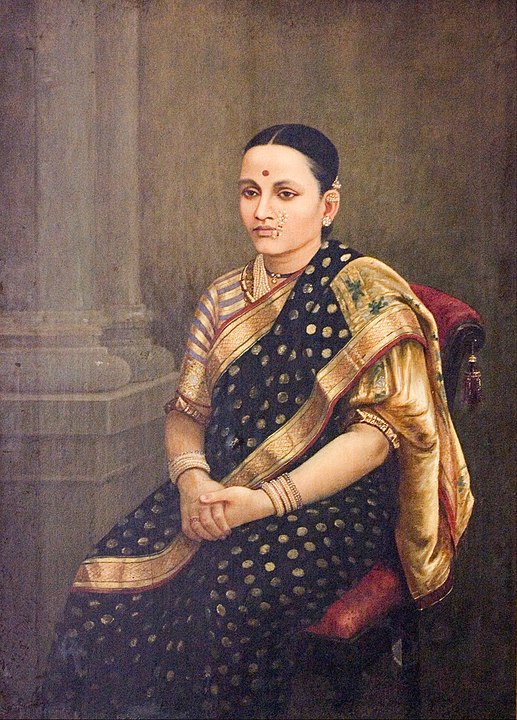
For anyone interested in Indian art, this is a must see gallery. The gallery has wonderful collections of miniature paintings, works from Nobel prize winner Rabindranath Tagore, Indian abstract art as well as a sculpture garden.
Jaipur House, the former residence of the Maharaja of Jaipur in Delhi, is adjacent to the main gallery building and has changing exhibitions. It is included in the price of the ticket.
There are free guided tours at 11:00 am, 1:30 pm and 3:30 pm.
- Hours & Cost: 11:00 am – 6:00 pm, daily (closed Monday); INR 500 foreigners, children under 18 free with ID
- Nearest metro station: Khan Market (Violet line), exit Gate 2
- What to see nearby: India Gate, National Crafts Museum and Hastkala Academy, Bikaner House
- Where to eat: Gulati, Diggin Cafe
21. State Emporiums on Baba Kharak Singh Road
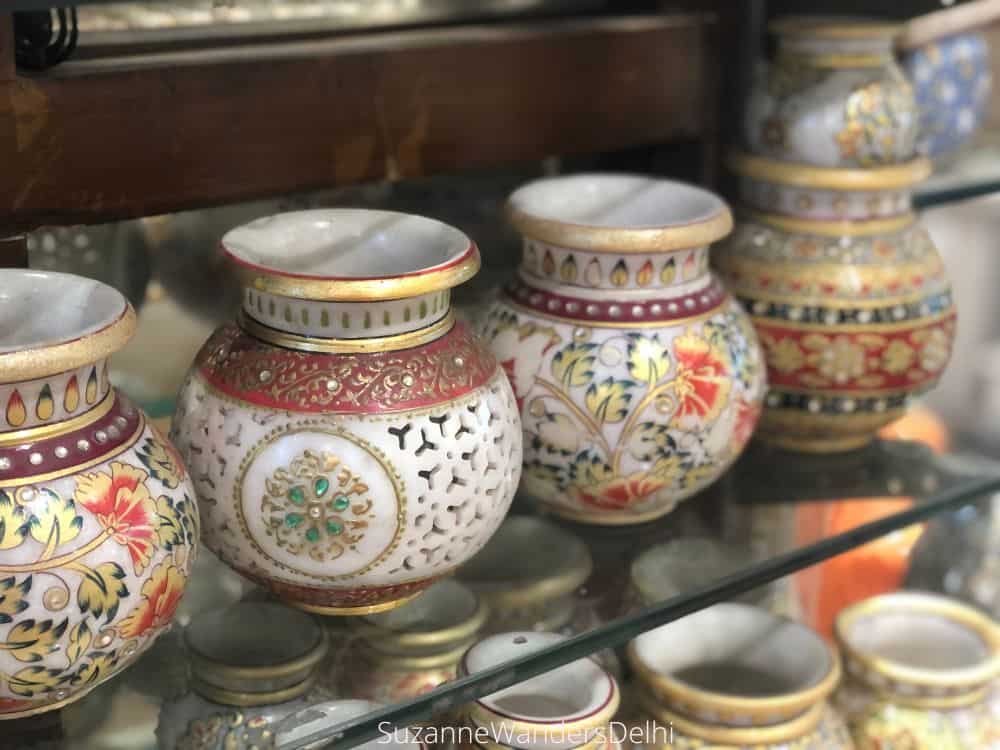
It’s possible to visit all the different states of India and learn about their handicrafts and culture in one day by taking a stroll on Baba Kharak Singh Road and visiting the state emporiums.
State emporiums are government run stores which sell state produced, authentic handicrafts and cultural items. They are an absolute treasure trove of India’s diverse art and culture. Prices are usually reasonable.
You can buy tea from Assam, hand-made carpets and pashminas from Kashmir, cotton and silk shawls from Bihar, Gujarati wood carvings, Rajasthani paintings, huge sandstone carvings from Odisha, pearls from Telangana, brass deities from Tamil Nadu, traditional saris from Kerala and warm sweaters and socks from Himachal – all in one day!
The emporiums are located on one side of Baba Kharak Singh Road, between Block P of Connaught Place and the Shivaji Stadium metro station entrance. They take up 4 blocks, so wear comfortable shoes.
- Hours & Cost: 10:30 am – 7:00 pm (hours can vary), daily; free
- Nearest metro station: Rajiv Chowk (Yellow or Blue line), exit Gate 7
- What to see nearby: Gurudwara Bangla Sahib, Jantar Mantar, Pracheen Hanuman Mandir
- Where to eat: Coffee Home, Farzi Cafe
22. Safdarjung Tomb
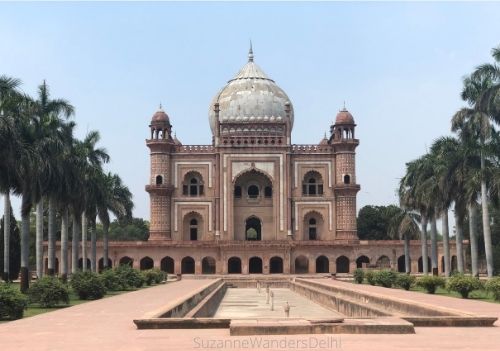
This is one of the most beautiful and atmospheric tombs in Delhi. Built at the end of the Mughal empire, it is the last Mughal garden style tomb built in India. If you go in the morning you may see peacocks.
In 1754 it was built for Nawab Safdarjung, a powerful Vazir (similar to a prime minister) of the Mughal Empire. In fact, he was so powerful, rival factions within the court ran him out of Delhi and he died shortly after. His son had to plead with Emperor Muhammad Shah to let him build the mausoleum.
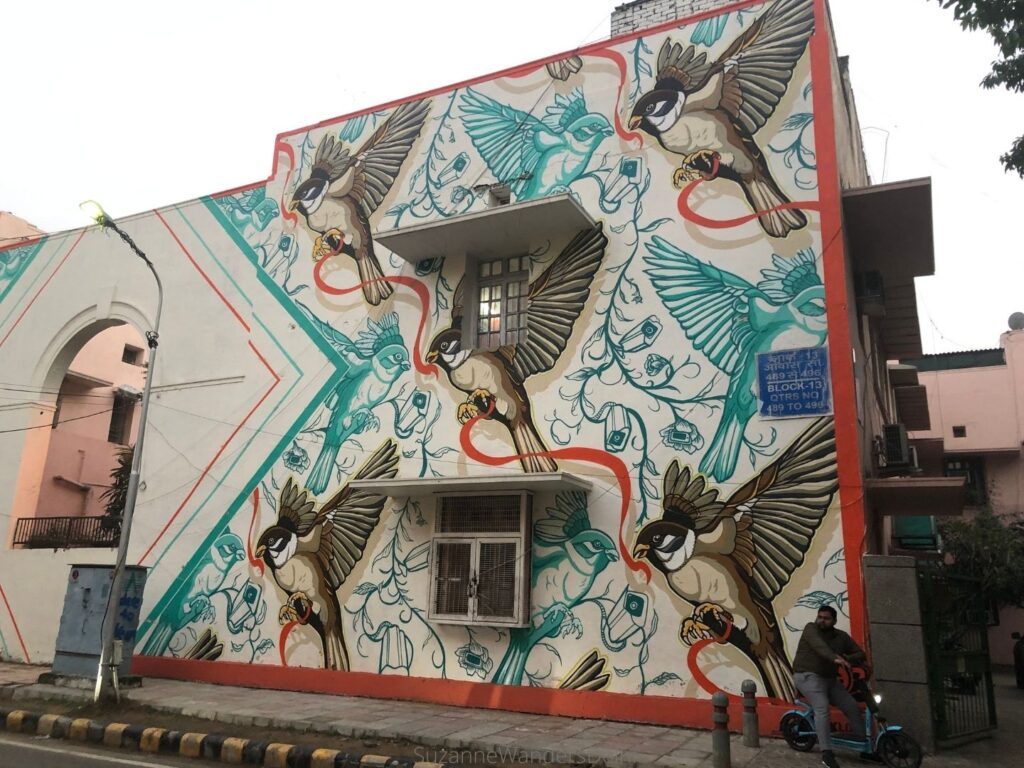
Because the tomb was built during the decline of the Mughal empire it was constructed with poor quality material. Marble and sandstone were even removed from other tombs to use on Safdarjung Tomb.
- Hours & Cost: 7:00 am – 9:00 pm, daily; INR 300, children under 15 free
- Nearest metro station: Jorbagh (Yellow line), exit Gate 2
- What to see nearby: Lodhi Garden, Lodhi Art District, Khan Market
- Where to eat: Habiteria, Habitat Hub, Jamun
23. Khan Market
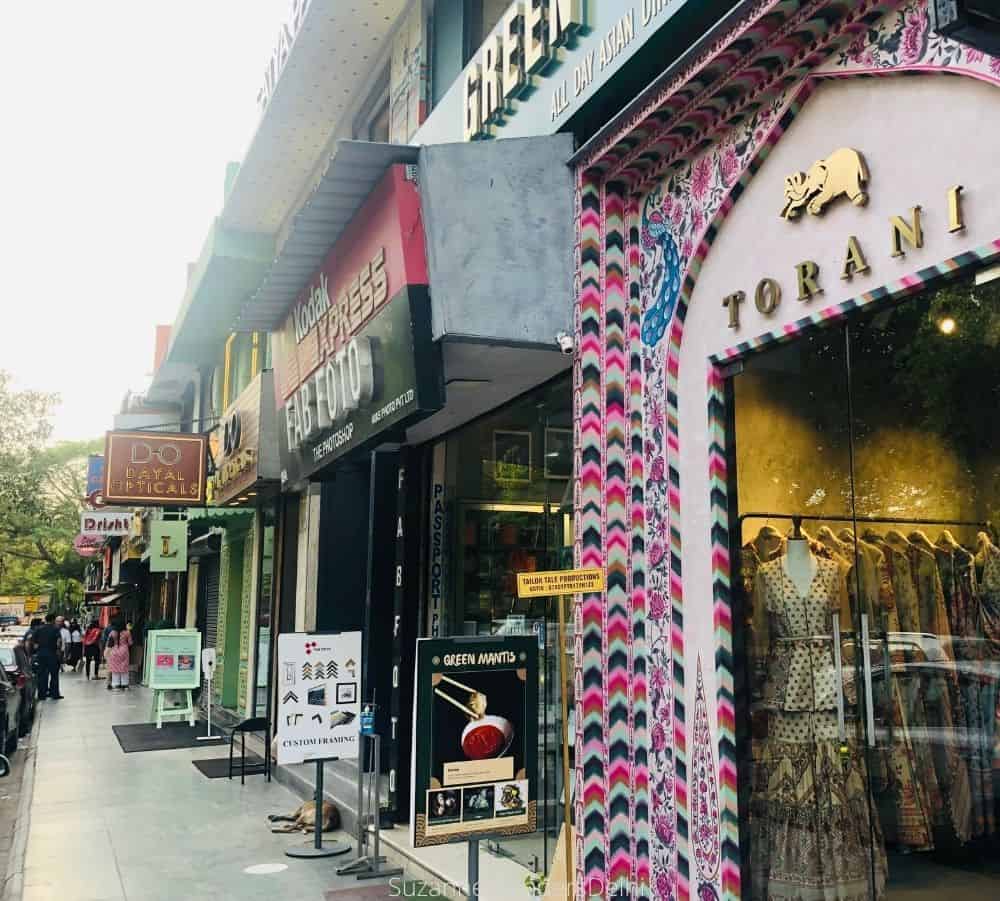
This is a favoured shopping district of expats and locals alike. Khan Market is more upscale, with international brand stores like Kiehl’s and L’Occitane as well as Indian brands and designers such as Fabindia, Ranna Gill and Ritu Kumar.
Two of my favorite bookstores are here too, Bahrisons and Faqir Chand. They both have a great selection of English books.
Besides retail, there are many restaurants, lounges, coffee shops and excellent bakeries.
- Hours & Cost: 10:00 am – 7:00 pm (shop hours vary, restaurants open around 12:00 pm – 11:00 pm), daily; free
- Nearest metro station: Khan Market (Violet line), exit Gate 4
- What to see nearby: Lodhi Garden, Lodhi Art District
- Where to eat: Khan Chacha, Colocal, The Big Chill Cafe
24. Agrasen ki Baoli

I love taking visitors to this stepwell. Not only is it conveniently located near so many other sites, it is truly an impressive monument.
The stepwell has three arched levels and 108 steps leading down to a water well. The black water of the well is rumoured to have mystical powers and able to lure people into drowning themselves.
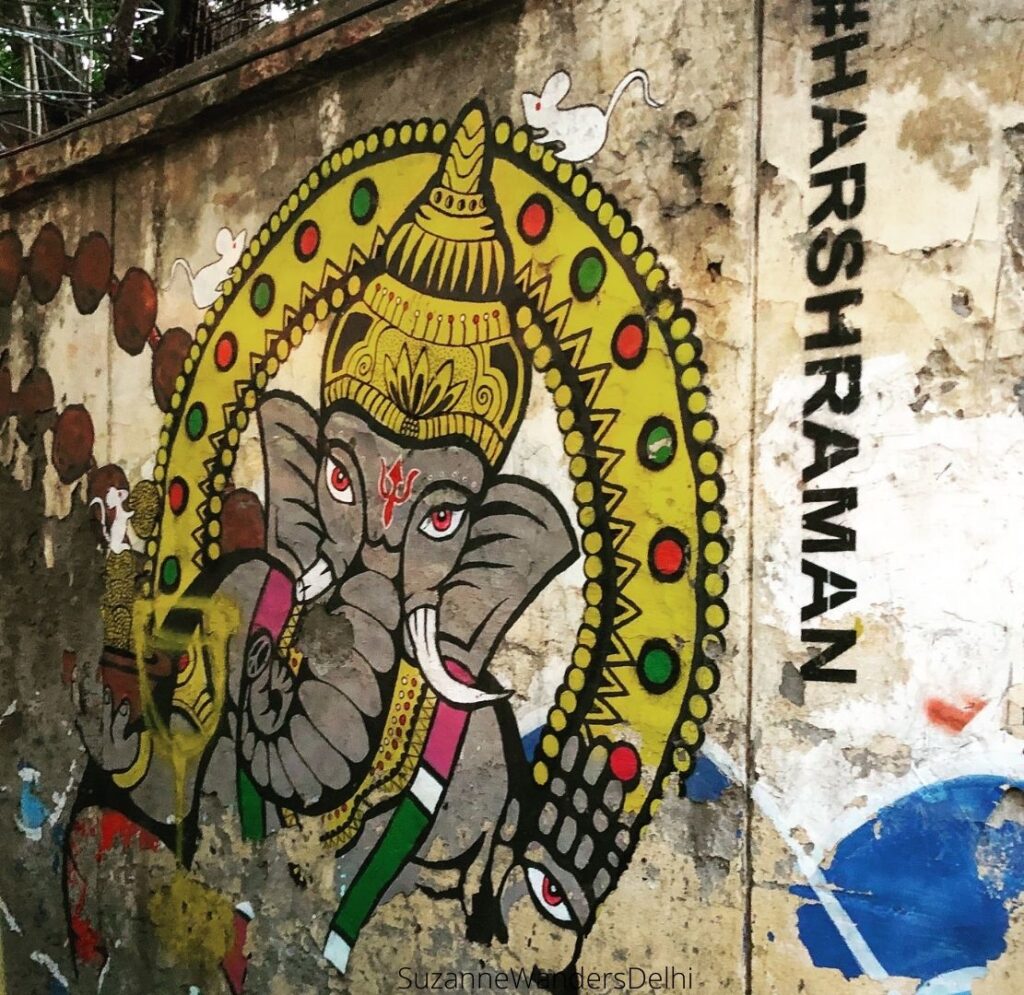
The current stepwell was rebuilt in the 14th century by the Agrawal community. The original was much older and dated back to 3000 BC. It is attributed to King Agrasen, an ancient king descended from the Hindu god Lord Ram.
Don’t miss the ruined mosque on the site. The roof is caved in, but you can see carvings on the columns.
- Hours & Cost: 9:00 am – 5:00 pm, daily; free
- Nearest metro station: Barakhamba Road (Blue line), exit Gate 4
- What to see nearby: Devi Prasad Dhobi Ghat, Connaught Place, Jantar Mantar
- Where to eat: The Tin Whistle (at the British Council – you will have to show ID and go through security), Saravana Bhavan
25. Purana Qila
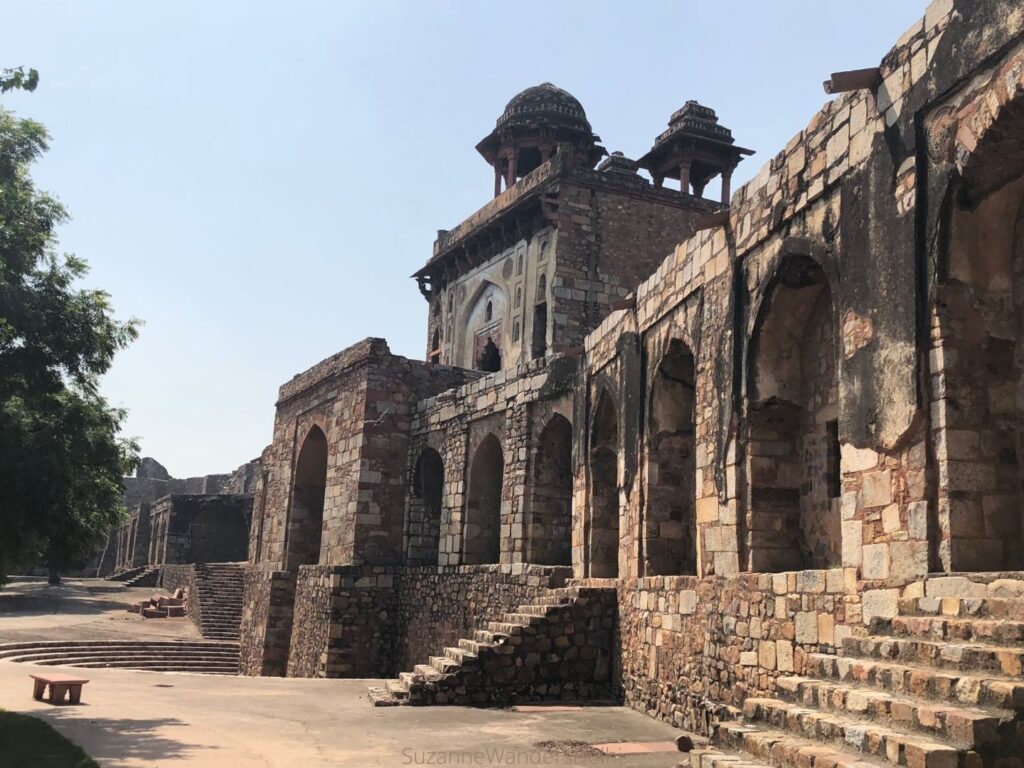
Purana Qila means Old Fort and it certainly lives up to its name. Historians have found pieces of pottery dating back to 300 BC and believe this may have been the location of the ancient city of Indraprastha.
The fort as we see it today was started by the Mughal ruler Humayun and completed by Sher Shah Suri in 1545.
It has massive stone fortifications, a mosque, stepwell, huge gates and the infamous library where Humayun tumbled head first down a flight of stairs to his death. He was rushing to the evening prayers.
- Hours & Cost: 10:00 am – 6:00 pm, daily; INR 300 foreigners, children under 15 free
- Nearest metro station: Supreme Court (Blue line), exit Gate 1 or 2
- What to see nearby: National Crafts Museum & Hastkala Academy, Sunder Nursery
- Where to eat: Golden Biryani, Cafe Lota (at National Crafts Museum & Hastkala Academy)
👍 Insider tip: Purana Qila has a good archaeological museum. There’s a nominal separate entrance fee.
26. Majnu ka Tilla (Little Tibet)

Majnu ka Tilla, Delhi’s Little Tibet, is famous for its Tibetan restaurants, cafes and budget shopping. The lanes are strung with Tibetan prayer flags and there’s two lovely Buddhist temples you can enter (don’t forget to remove your shoes first). The shops sell clothing, electronic gadgets and Buddhist objects.
The colony is home to about 3,500 second generation Tibetan exiles. They started coming to Delhi in 1959 after the Dalai Lama was exiled to Dharamshala, in northern India.
There is some great budget shopping here but I like to come for the Tibetan feel of the place and the food. Make sure you try the Tibetan street food, laphing. It is vegetarian, spicy and delicious! There’s a lady with a stall just outside the monastery.
👍 Insider Tip: If you’re interested in Tibetan culture, Delhi has a Tibetan and Buddhist centre called Tibet House. It was founded by His Holiness the Dalai Lama and is open to the public.
- Hours & Cost: 24/7 but shops are open 11:00 am – 9:00 pm, daily; free
- Nearest metro station: Vidhan Sabha (Yellow line), exit Gate 2
- What to see nearby: Monastery Market, Ladakh Buddhist Vihara, Flagstaff Tower
- Where to eat: Lhasa Cafe, Nirvana Thakali Kitchen, AMA Cafe
27. Jantar Mantar
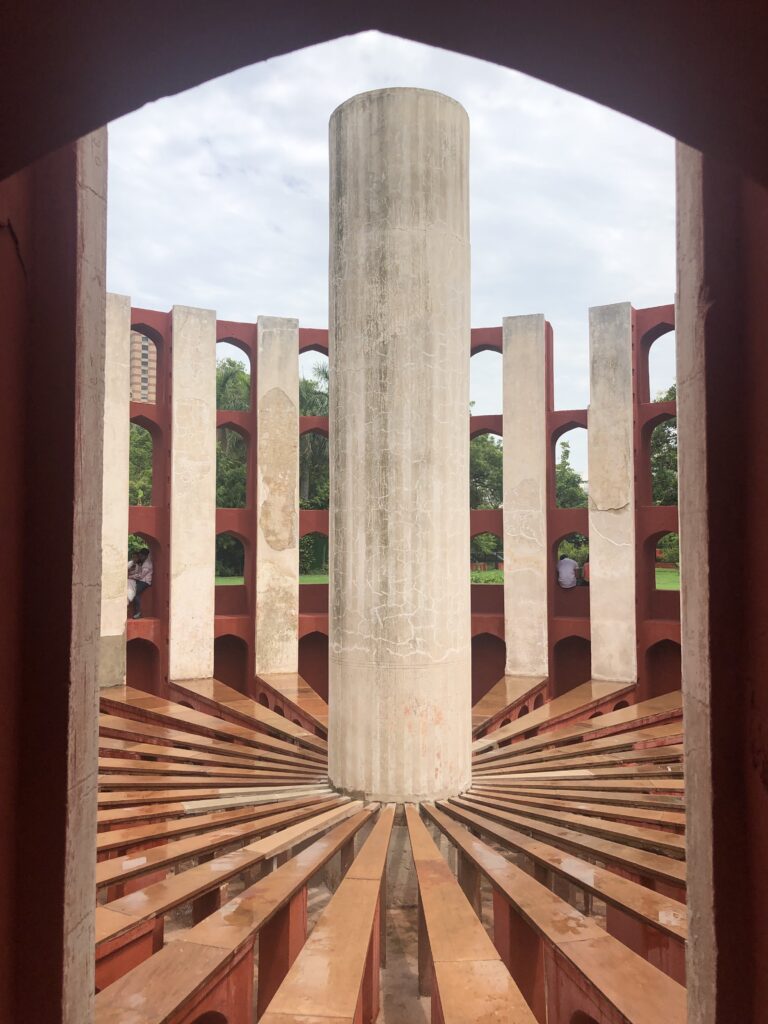
For anyone interested in science or astronomy this is a must see site. It is a group of 13 architectural astronomy instruments built in 1724. I brought a Canadian science teacher friend of mine here and she was fascinated.
This jantar mantar is actually one of four remaining jantar mantars built in India by the Maharaja Jai Singh II. The largest of the four is in Jaipur.
Jantar Mantar literally means “instruments for measuring the harmony of the heavens.” These instruments are massive and it’s amazing how accurate they were.
Today, the fine calibrated markings on the instruments are severely eroded and they are in need of restoration and protection.
- Hours & Cost: 6:00 am – 6:00 pm, daily; INR 300 foreigners, children under 15 free
- Nearest metro station: Janpath (Violet line), exit Gate 2
- What to see nearby: Connaught Place, Janpath Market, Agrasen ki Baoli
- Where to eat: The Atrium or 1911 Restaurant (both in the Imperial Hotel), Pind Balluchi
28. Rashtrapati Bhavan
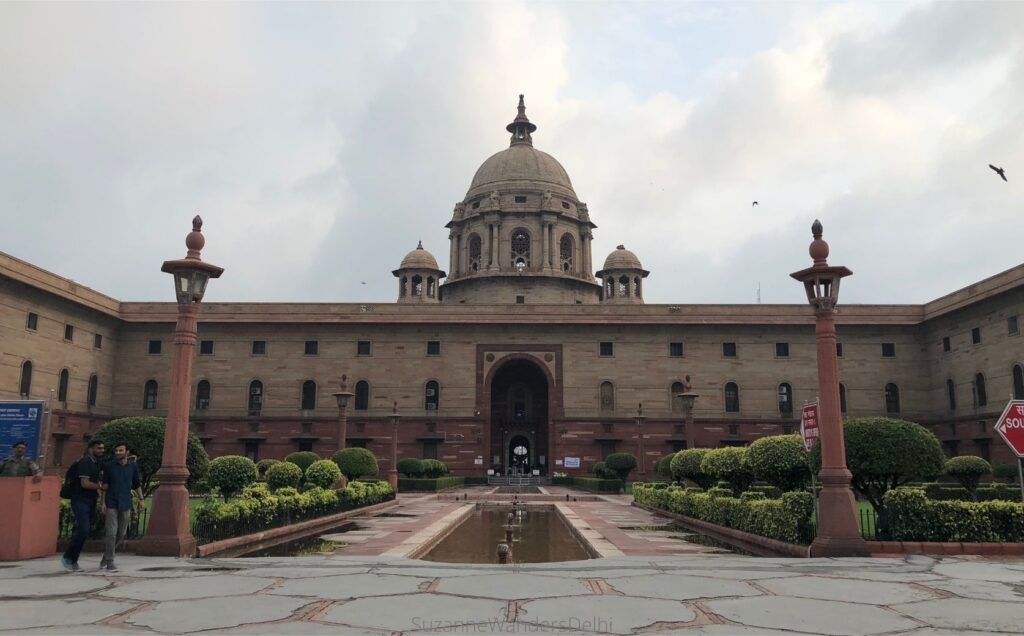
This is the official residence of the President of India. It is the largest residence of any head of state in the world, and is 50 times larger than the White House.
The entire Presidential estate is 320 acres and features Mughal style gardens, residences for staff, horse stables and the Presidential mansion with 340 rooms.
Back in the time of the British Raj, it was the home of the Viceroy of India (the British regent in India). It was completed in 1929 and designed by Sir Edwin Lutyens and Herbert Baker, forming part of Lutyens’ Delhi.
Rashtrapati Bhavan was named after Chakravarti Rajagopalachari, the first Indian to reside in Government House (as it was then called). He found the Viceroy’s rooms too grand and felt more comfortable living in the guest wing. Since then all Presidents have used the guest wing and the Viceroy’s rooms are now for visiting heads of state and dignitaries.
Entrance Gates at Rashtrapati Bhavan
- Circuit 1 (main building & central lawn) – Entry Gate No. 2, 37 or 38
- Mughal Gardens – Entry Gate No. 35
- Changing of the Guard – Entry Gate No. 2 or 37
Several tours of the palace, Rashtrapati Bhavan Museum and gardens are available. Every Saturday morning at 8:00 am there is a changing of the guard ceremony. Visitors must have an online booking to enter the grounds of Rashtrapati Bhavan.
You can book online on the Rashtrapati Bhavan website.
- Hours & Cost: 9:30 am – 4:00 pm (main building and central lawn open Saturday and Sunday, museum closed Monday – check ahead, hours can vary); INR 50
- Nearest metro station: Central Secretariat (Yellow line), exit Gate 4 or 5
- What to see nearby: India Gate, Pradhanmantri Sangrahalaya, Gandhi Smriti Museum
- Where to eat: Mysore Cafe, Andhra Pradesh Bhavan
29. See a Bollywood Film
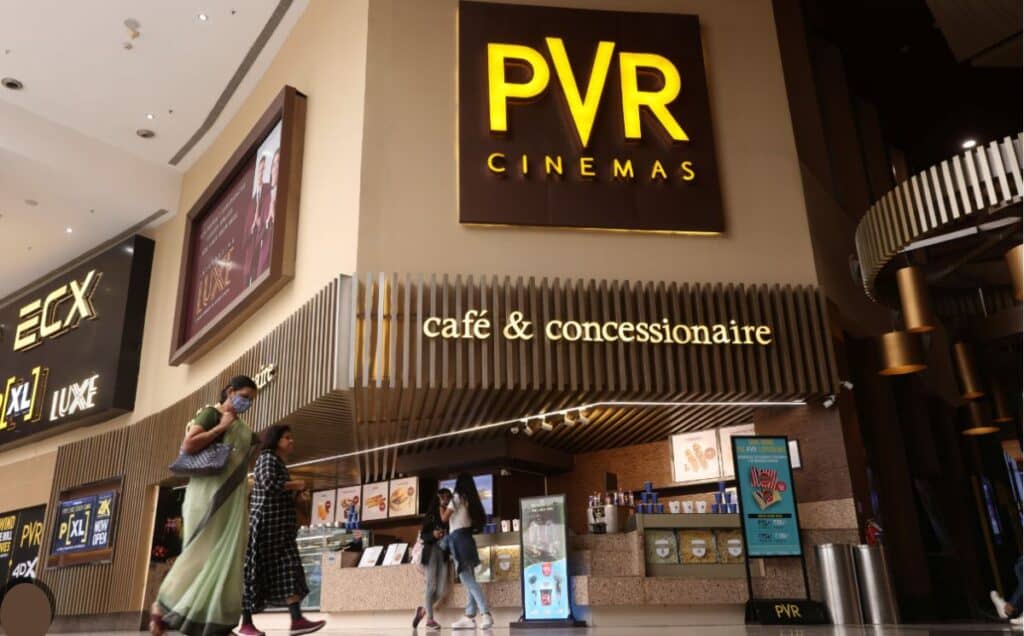
Indians love their movies and Bollywood produces more movies than Hollywood. Most Bollywood movies will not have English subtitles but it’s still fun to go. The movies usually don’t have complicated story lines and it’s not too difficult to follow along. Comedies are especially good for this.
Audience reactions during the movie can be as entertaining as the movie itself. During my first Bollywood movie, the extremely fit hero took off his shirt and the audience exploded in exuberant whistles and clapping which continued for several minutes.
Connaught Place has several older cinemas halls like the Odeon, Rivoli or Carnival Cinemas. These cinemas may not have all the modern conveniences, but they do have charm. You can find cinemas in many neighbourhoods, and all the major malls have modern cinemas.
Movie tickets can be booked online in advance at BookMyShow.
- Hours & Cost: 11:00 am – 11:00 pm (hours vary), daily; INR 250 to 1000
- Where to eat: cinemas sell snacks, and some sell proper meals like biryani, chicken tikka and pizza
Prices and Tickets for Historical Monuments
You can buy tickets online for many of the historic monuments on the Archeological Survey of India website. It will save you lining up for tickets (but if you do, make sure you get into the foreigner line up), and tickets are INR 50 cheaper online.
Many sites in Delhi charge a much lower entrance fee for Indians and nationals from other south east Asian countries (SAARC and BIMSTEC). This is to ensure sites of historical and cultural interest are accessible to all.
How to Get to Get Around Delhi
I recommend using the Delhi metro to get around. It’s an excellent system – air conditioned, efficient, clean and inexpensive. In traffic clogged Delhi, riding the metro is the best way to move around the city.
If your destination is too far to walk from the metro, grab an auto rickshaw. They are always outside metro stations and attractions. Agree on the price before you get in. Generally, a short ride of 2 km is about INR 80.
Uber and Ola are also very widely used in Delhi and reliable. You will need some kind of data plan to utilize these but you can get a cheap SIM card at the airport on arrival. BluSmart is another popular ride-share app in Delhi that only uses electric cars.
Another option is to hire a car and driver for a day or half day. Your hotel or guest house can arrange this for you. It’s pretty affordable in Delhi. Uber also offers a multi hour option, and you can make multiple stops.
Where to Stay
South Delhi is the best part of Delhi to stay in. It is a greener, quieter and safer part of the city where many expats live. It is also well connected by Delhi metro, and where many of the city’s top sites and things to do are located. These are my top picks for South Delhi hotels:
Prakash Kutir Bed & Breakfast
This is a wonderful (and super clean) family run guest house. You can walk to shops, restaurants, several historic sites and the metro. It’s in Hauz Khas, a very good South Delhi residential neighbourhood. A home cooked breakfast is included.
📍Check prices and availability at Prakash Kutir Bed & Breakfast
Lutyens Bungalow (mid-range)
This heritage property has an incredible location right beside Lodhi Garden. It’s the loveliest part of Delhi. Rooms are simple but comfortable, and breakfast is included. Peacocks often frequent the gardens. There is an outdoor pool.
📍Check prices and availability at Lutyens Bungalow
Leela Palace New Delhi (luxury)
The Leela Palace is five star property and Delhi’s most beautiful hotel. It’s in Delhi’s most exclusive neighbourhood, Chanakyapuri, where many embassies are located. It has all the amenities you would expect of a luxury hotel and service is superb.
📍Check prices and availability at Leela Palace New Delhi
FAQs
Yes, Delhi has 3 UNESCO sites: Red Fort, Qutub Minar and Humayun’s Tomb.
The best months are October, November, February and March. The beginning of December and April are also pretty good in terms of weather.
Delhi is an enormous city and has so much to see and do, but with 4-5 days you could cover a lot. This will give you time to see the most important sites and some off the beaten path treasures.
The Wrap-up on 29 Amazing Things to Do in Delhi
Delhi is such an incredible city, and this is by no means the only things there are to do, but it’s a really good start. You will be well on your way to discovering what the city has to offer with this list. To make sure you cover all the bases, check out my 5 day Delhi itineraries.
In Delhi, there is something of interest practically around every corner. The city is full of surprises!
Don’t forget travel insurance! It’s always a good idea to carry travel insurance just in case something goes wrong. I really like and use SafetyWing
